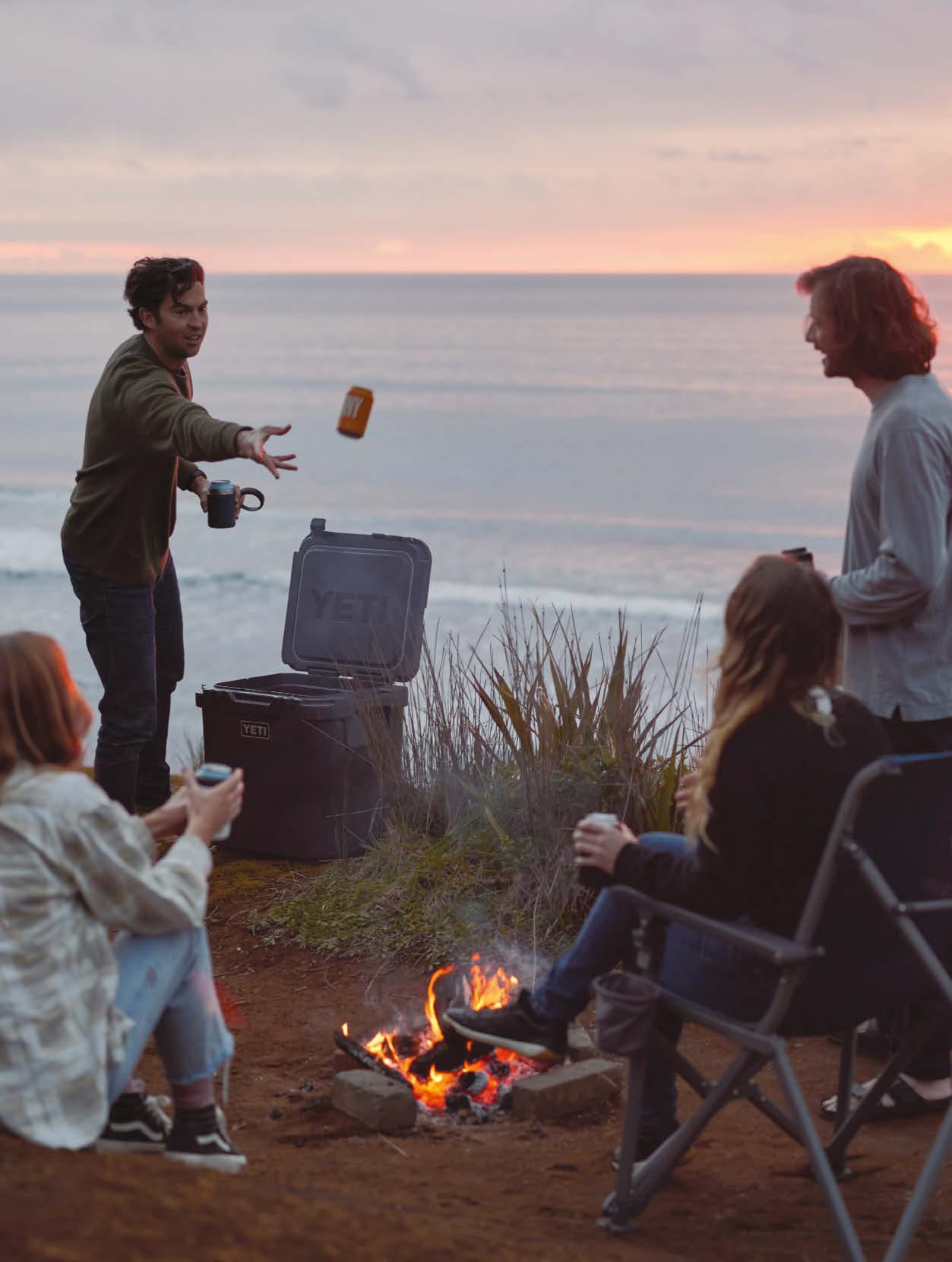SKATER CURATOR



TRANSCEND BOUNDARIES






The photographer, who is based in Spain and has been published by The New York Times and Rolling Stone among others, travelled into the mountains to shoot cyclist Wout van Aert. “It was a dream assignment,” he says, “because I’m a cycling fan, and Wout van Aert is one of the world’s best cyclists. To see him in action, riding in the Sierra Nevada mountains, was fabulous.” Page 50
When an eight-year-old Letícia Bufoni (page 30) first started to skateboard in São Paulo, Brazil – the only girl among boys – it would have been impossible to imagine that more than 20 years later she’d be kickflipping a dinosaur skeleton in London’s Natural History Museum alongside the leading lights of the international and UK women’s scenes. But, as the champion skateboarder and this month’s cover star proves, perseverance can take you to great places.

This is a lesson that Belgian cycling champion Wout van Aert (page 50) has learnt on his mission to conquer multiple disciplines against the world’s best competitors. “I always want to give it a go,” he says. “A lot of people don’t try it, because they think they can’t.” We join him in the Spanish mountains to find out how this attitude is paying dividends.
Then we meet up-and-coming Chicago singer/songwriter


The Ohio-born, Chicago-based music-scene photographer ventured to the Broken Arrow Horseback Riding Club to shoot rising star and fellow Windy City resident Kara Jackson for this issue of The Red Bulletin. “Working with Kara is a dream,” Dye says of the singer/songwriter. “As well as being one of my favourite musicians, she has impeccable styling skills. I was happy to play a small role in the magic.” Page 42
Kara Jackson (page 42), who tackles the relatable topics of heartbreak and grief with warmth and humour, affirming the emotional stamina that we all manage to muster in life.
Enjoy the issue.
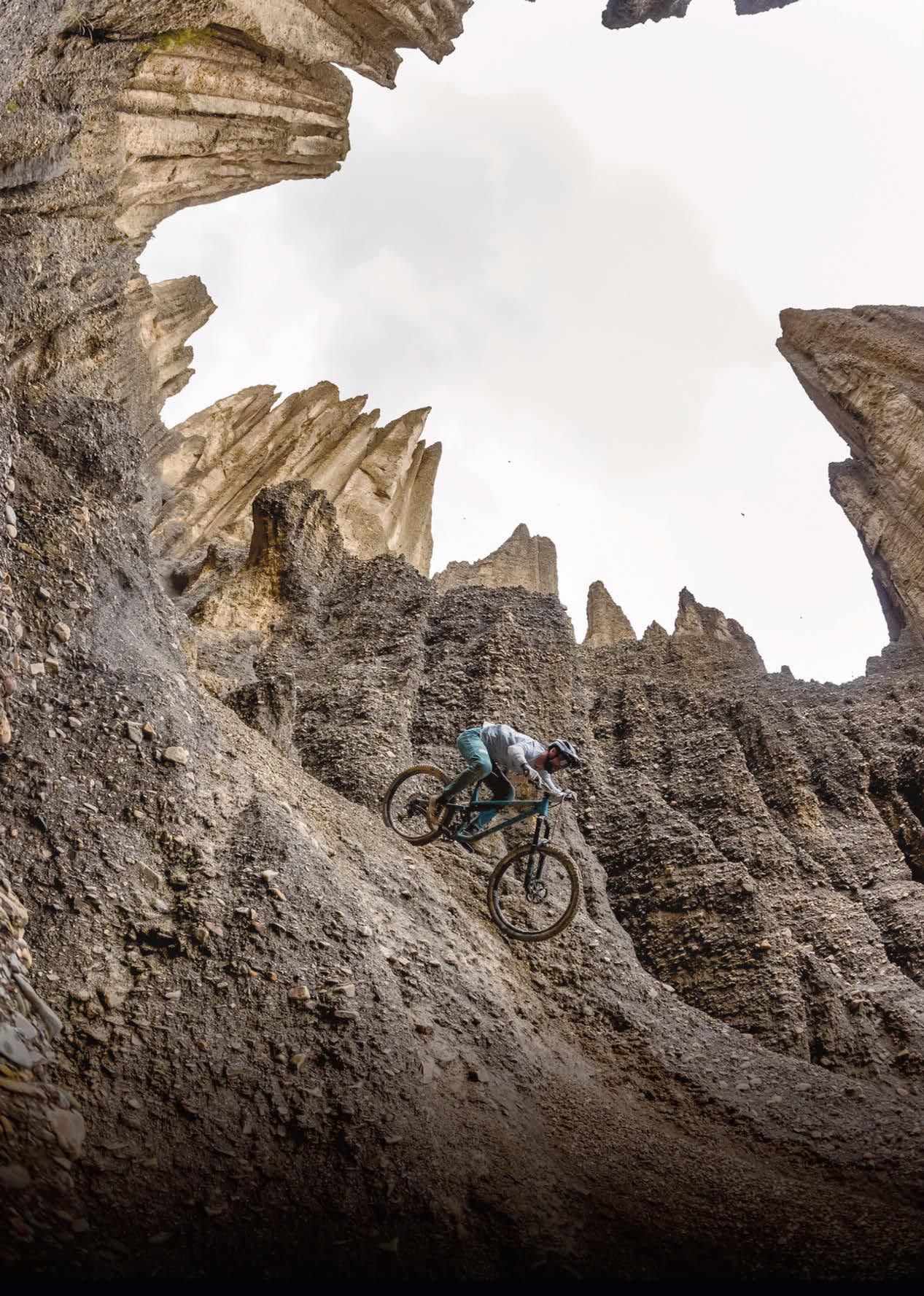








8 Gallery: BMX time in southeast France; a B-boying workshop in Kazakhstan; taking a street artist to court in Rome, and high-flying supercross in Utah
15 Blast from the past: entertainment polymath Nick Cannon returns to the roots of his R&B infatuation
16 Cup game: Portland bar The Sports Bra is providing a space for women’s sport to thrive
18 Planet Fantastique: welcome to a pastel-hued utopian future that Captain Kirk would have died for
20 Street food: access the urban feast that lines your route to work (and no, we don’t mean Greggs)
22 ClimbMuz: the London-based climbing community that helps Muslim women reach their goals
24 Teflon Sega
Metaverse, chorus, metaverse: the anime singer – or, rather, his creator – talks art, avatars and anonymity
26 Jalessa Vincent
Fear isn’t in the vocabulary of this punk-band-fronting, board-brandowning, maverick surf pro
28 Naomi Schiff
The racing driver, stunt actor and Formula 1 presenter who’s pushing for more diversity in motorsports
30 Letícia Bufoni
How the Brazilian skate icon and her peers taught some very old dinosaurs some gnarly new tricks
42 Kara Jackson
Following a personal tragedy, this Chicago folk singer gave her grief a voice, and it’s one to treasure
50 Wout van Aert
The Belgian pro rider isn’t content to win just cyclo-cross – every discipline is there to be conquered
60 Max Verstappen
The Dutch world champion didn’t always dominate F1 – it just feels that way. Here’s how he achieved it…
67 Pack and paddle: cross-country swimming in the Lake District
73 Speed freak: the Ribble Ultra SL R
74 Golden age: septuagenarian runner Hans Smeets is unstoppable
76 Double trouble: when it comes to rivalry, twins take some beating
79 Bricking it: LEGO Pac-Man Arcade
80 Saber truth: a class in Jedi combat
82 Taking charge: your e-bike commute made easy
93 High bar: our pick of Peckham
94 Essential dates for your calendar
98 Outdoors wisdom from Semi-Rad
Wout, there it is: cycling phenom Wout van Aert eats challenges for breakfast (though we can’t confirm what his other meals entail)

The key to reading an analogue watch face is noting the position of its hands. The same goes for navigating one on a BMX, it would appear. “[The hands] were unstoppable… it was a bit Ninja Warrior,” says flatland BMX world champ Matthias Dandois, who this January realised his dream to land tricks on a giant timepiece. A coproduction by Red Bull and Swatch, the Time Machine project exceeded expectations: history books show that in 1683 Dandois was spotted teaching Louis XIV the ‘no-hander balance’ in the gardens at Versailles. Watch it at redbull.com


In the school of B-boying, break time has the opposite meaning – it’s when lessons begin. Your tutor here is Martinique-born, Paris-based B-boy Lagaet – aka 35-year-old Gaëtan Alin – pictured giving a workshop at the Red Bull BC One Cypher in Kazakhstan in March this year. A member of both Dutch crew The Ruggeds and Portugal’s Momentum Crew, the three-time BC One finalist was in the Central Asian country to pass on his knowledge and skills to local breakers in the lead-up to the national final in Almaty, which was won by B-boy Create. Like they say: those who can, teach…
For more, check out the Red Bull BC One channel on YouTube

Talk to a basketball fan about ‘the paint’ on a court and they’ll think you mean the rectangular area under the basket. Street artist Piskv would give a different answer. The Italian (that’s him in the centre circle) was invited to redesign the basketball space in San Lorenzo, Rome, as part of Red Bull Half Court, the three-on-three tournament that’s rejuvenating the grassroots game globally. He found inspiration in a local landmark: “I inserted the outline of the Colosseum into the shapes of the playground [for] a strong identity,” says Piskv, aka Francesco Persichella. “A player stands out in the Colosseum in the act of a dunk, the most famous act of street basketball.” Game on. For more on Red Bull Hard Court, go to redbull.com


When your vision is assaulted by barriers telling you to fly, it’s no wonder a rider takes to the air. The guy in (OK, off) the saddle is Aaron Plessinger – a 2018 champion in both supercross and motocross – racing in Round 17 of the AMA Supercross Series at RiceEccles Stadium this May. When he eventually landed, the 27-year-old Ohio native, who’d missed the previous three rounds through injury, took the runner-up spot in front of a sold-out crowd of 49,871 fans. How’s that for a comeback? redbullcontentpool.com

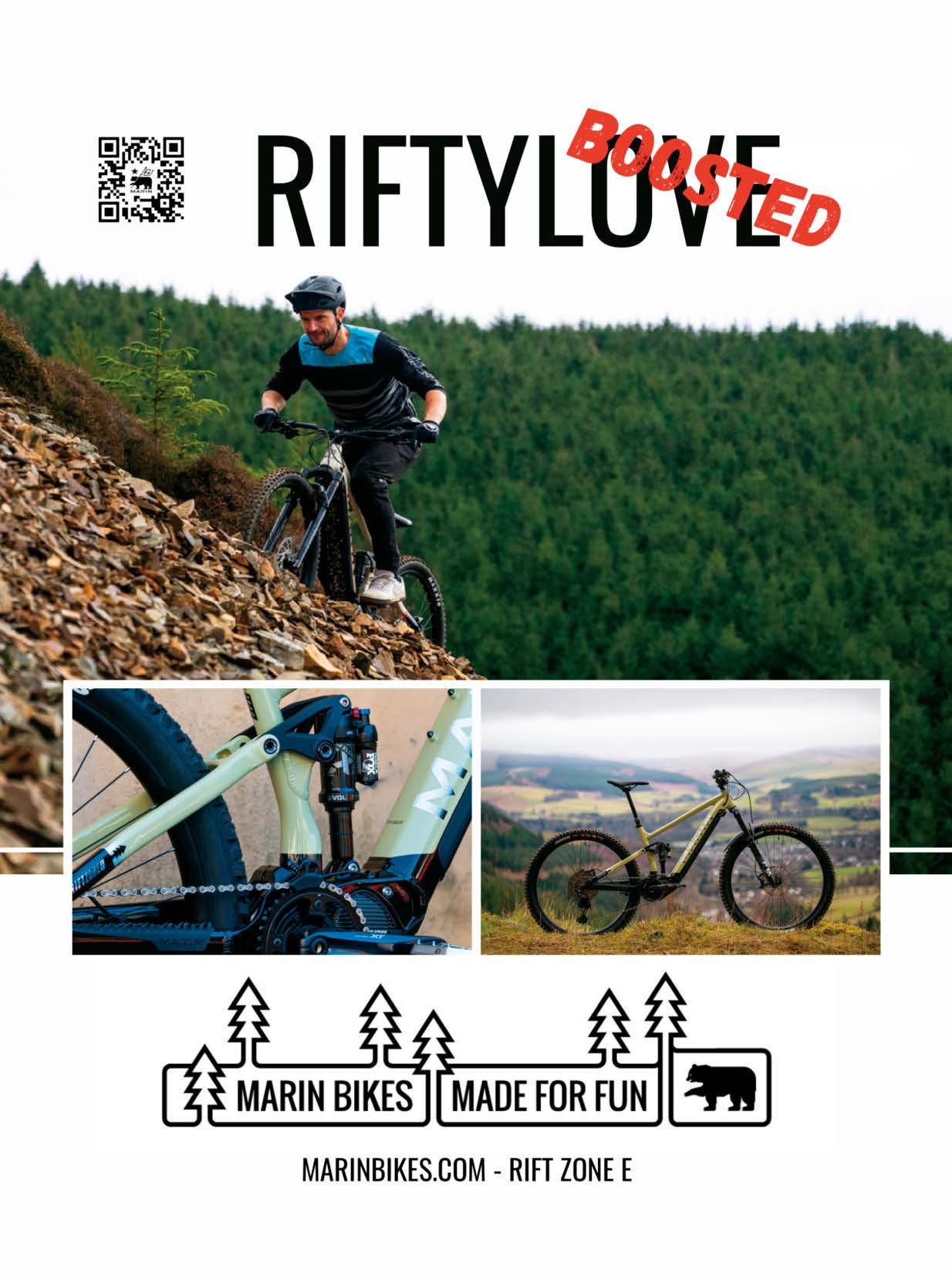
Nick Cannon is one busy man. As well as a music artist, actor and comedian, the 42-year-old is currently executive producer and host of America’s hit singing contest TV show The Masked Singer. But it’s been two decades since the release of his eponymous debut rap album. Now, Cannon is back with The Explicit Tape: Raw & B, which sees him switch genres to R&B. “People are always drawing their own conclusions on my personal life,” explains the entertainment mogul, who has fathered 12 children, “so I just wanted to give them the raw truth.” Here, Cannon picks four tracks that shaped his love for R&B and inspired his latest project. The Explicit Tape: Raw & B is out now; nickcannon.com


“I work out to this song every morning. It speaks to my purpose. It gets me locked into my mission. I wouldn’t say it reminds me of my life; it’s more about just knowing that when all eyes are on you, and people have opinions about you and your family… we all have challenges and issues. If we come together as humanity, we can get through it.”
Michael Jackson
PYT (Pretty Young Thing) (1982)
“I was introduced to the Thriller album the way the rest of the world was: it was everywhere. [It was] in the grocery store, on the television… My mom would play the album and we’d get excited for Beat It, Billie Jean and Thriller, but PYT was my favourite. It was an album track, so you had to be a real fan to appreciate it.”

A Song for You (1971)

“The first time I ever heard this was as a kid getting ready for church on Sunday. It felt like gospel, but really it’s not –it’s a song about love. Growing up as a PK [preacher’s kid], certain types of music – like the stuff I was listening to every day – weren’t allowed in the house, but Donny Hathaway could be listened to all the time.”
“I feel like the New Jack Swing era was my era. It was probably around the age I started liking girls. I’d perform this song in the playground during recess and create dance choreography to it. When I first heard it on the radio, I thought it was Stevie Wonder on vocals, like a hip-hop version. But then the DJ comes on and says it’s this new group called Guy.”
 Donny Hathaway
Songs from an R&B love story, handpicked by the American rapper turned entertainment mogul
Donny Hathaway
Songs from an R&B love story, handpicked by the American rapper turned entertainment mogul
Frustrated by the lack of options to watch women’s sports while out drinking with friends, Jenny Nguyen decided to do something about it
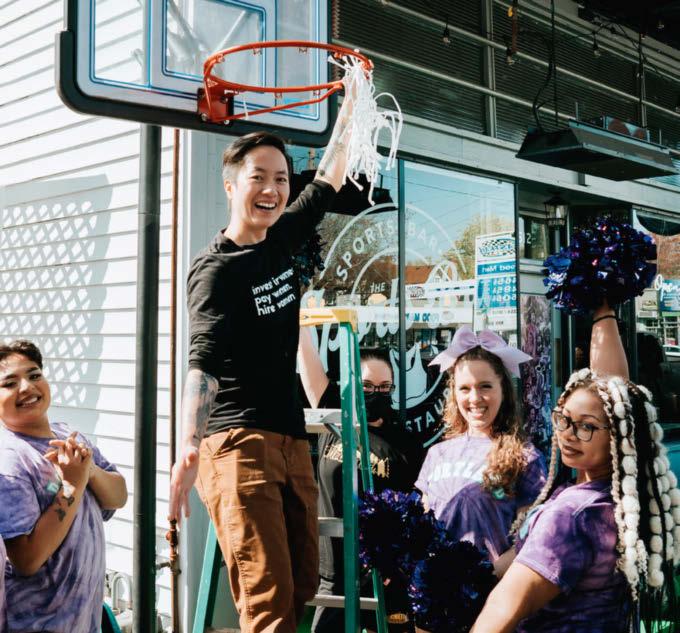
On a weekday night in 2018, Jenny Nguyen went to a sports bar with friends to watch Notre Dame play Mississippi State in the final game of that season’s NCAA women’s basketball championship. It was the only major game that night, but none of the 32 screens in the bar was showing it. Nguyen’s sizeable group asked to see it and were given one TV in the back. They ordered food, drank beers and witnessed one of the greatest finishes in NCAA history, with the team from Indiana hitting a last-second three-pointer to win the title.
“I remember throwing my hat across the bar as we all screamed and lost it,” Nguyen says. “That’s when we realised no one else in the bar knew why we were cheering. We’d watched the entire game with the sound turned off by the bar. We hadn’t even questioned it.”
Decades of experiences just like this inspired the 43-year-old to launch The Sports Bra. The bar in Portland, Oregon, is dedicated to showing women’s sports and offering a space that “supports, empowers and promotes girls and women in sports and in the community”. Unbelievably, it’s the first of its kind in the world.

Nguyen, a medical graduate who spent years working in the restaurant industry – three of them as executive chef at a Portland college – was looking for a new direction when she hatched the idea for The Sports Bra. In February last year, she launched a Kickstarter to make it happen. The goal of $48,700 was soon surpassed: in the end, supporters across the world donated more than $105,000.
“I had never felt so certain of something before,” says Nguyen, who had played college basketball until an ACL injury forced her retirement. “I had this vision of what seeing more women’s sport would have meant to me when I was younger, and the impact it would have made on me. I felt like I had to make it a reality.”
Opened in April last year, The Sports Bra excludes no one from coming through its doors; it simply gives women’s sports the space they don’t get in other sports bars. “The statistics are that 95 per cent of all sports on TV and in the media are male, so this bar highlights the other five per cent and tells the stories people never hear,” Nguyen says. “We’re not only talking about women but about all the other sports stories that don’t get space: non-binary athletes, trans athletes... A space like this is so important not just for women but for the intersectionalities of all those underrepresented folks.”
People now travel from all over the world to sit in The Sports Bra’s booths and watch a game, and Nguyen hopes to open similar bars in other states and countries. “Every day, I see the impact of what we’re doing,” she says. “In the first couple of months of being open, two little girls were here with their dad, and they couldn’t take their eyes off the sports on our TVs. As I walked by, the dad touched my arm and said, ‘Thank you for giving my daughters this place.’ That’s what this bar is. That’s what we’re doing here.”
thesportsbrapdx.com

Using the AI software of our dystopian present, this London-based artist is creating a futuristic paradise inspired by the past

As a child, Sienna O’Rourke loved science fiction. The 31-year-old London-based artist would watch the original Star Trek TV series from the 1960s and marvel over the era’s notion of a futuristic aesthetic as well as the moral code of Captain Kirk and his team, who seemed so ahead of their time with their focus on equality and fairness to all. The one thing that O’Rourke couldn’t resolve, however, was the lack of a female representation on the screen. “The stories were amazing,” she says, “but it could all be quite masculine.”
Now, almost three decades on, O’Rourke has created a response to that deficit with Planet Fantastique, an AI project – named after the 1973 French experimental science-fiction art film – which refocuses the ideas of ’60s sci-fi through a different, more feminine perspective.
The world of Planet Fantastique is made up of saturated pastel hues and soft lines, a place where ’60s chic mixes with otherworldly landscapes through a kitschy filmic lens. There are American football jocks in floral felted helmets; elaborately dressed superheroes doing their weekly shop; vast Wes Andersonworthy submarines, and goldfish-filled headpieces.
“Retro futurism in the ’50s and ’60s was just futurism,

projecting to where we are now,” O’Rourke says. “I’m interested in the idea of people at that time imagining utopian societies where there’s no racism or prejudice, and where we have all these technologies that make our life so easy. Peaceful, beautiful science fiction.”
In our modern world, many are obsessed with creating dystopian fictions; O’Rourke’s project chooses to look in the other direction. “We are now in the time they were imagining
and it’s absolutely not [what they envisaged],” she says. “So this is an alternative. What could have been?”
O’Rourke created the project using AI software, entering a series of textual and visual prompts to create the uncanny world her characters inhabit. Though initially driven by a wariness of the controversial new technology, which many artists perceive as a threat, she now believes that AI and
tech-produced art can be embraced and used to benefit human artists rather than impede them. “Anyone can put a prompt into an AI generator and get something out of it,” O’Rourke says. “Artistic vision comes with the curation of that output and being able to clearly communicate what you want. I can understand why people are a bit apprehensive, but [AI programs] can’t create in a vacuum. As an artist, you
can see it as a tool to enhance your practice rather than just being a threat. It’s in its Wild West stage, but there are ethical ways to use it. Users need to act in good faith.”
The future of Planet Fantastique could lie on the big screen, with hopes of developing the project into a story-led film. “One area where AI software has so much potential is to sell something that will then be created in the real world,” O’Rourke

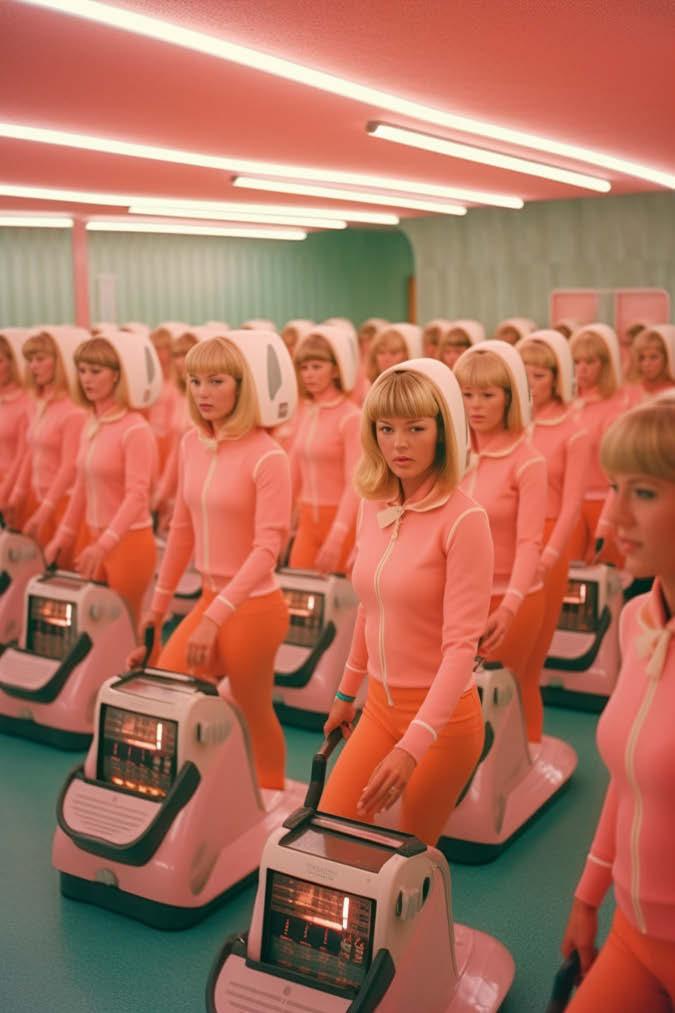
explains. “That’s where it’s such an amazing tool. I think it will revolutionise the pitching process in the film industry.

“New technologies are often met with resistance from the old guard. My view is that the cat’s out of the bag. AI exists, and it’s only going to keep getting more userfriendly and intelligent. I think, in many ways, that’s a really exciting prospect.”
For more, go to Instagram: @planet_fantastique
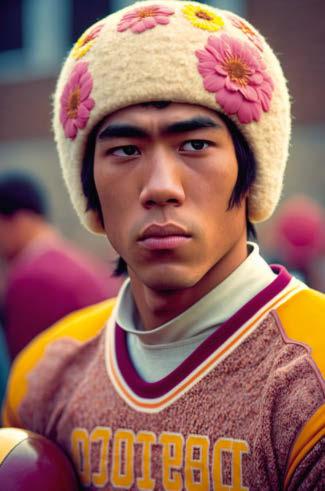
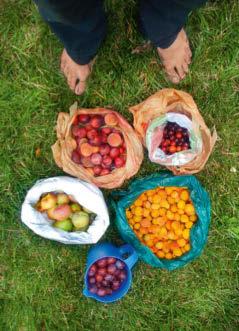
This open-source database is enabling people around the world to forage in the streets of their city, reconnecting with the origins of their food
Where does your food come from? It’s a question that many of us couldn’t answer. In an age of packaged supermarket produce, growing or harvesting our own fruit and vegetables can seem old-fashioned and unnecessary. But look around your city and, from elderflower and garlic on the side of the road to apple trees in the local park, food is growing everywhere for free.
Falling Fruit, a global opensource database created by foragers Ethan Welty and Caleb Phillips, seeks to restore the connection between humans and their food by mapping edible plants and giving people the knowledge to harvest from their urban environment.

The idea for Falling Fruit came, as many great ideas do, over a pint – or, at least, the intention to make one. “There were two apple trees in the backyard of my first house in
Boulder [Colorado],” explains Welty. “I had already learnt how to make my own beer, so I decided to make my own cider. I wasn’t getting enough apples from my backyard, so I started to consider whether I could harvest more from other trees in the city. Some friends pointed me to apple trees that were overhanging a bike route and were very productive.”
Welty’s search for apples coincided with an academic study he was working on, estimating how much food could be grown in Boulder based on the amount of available exposed ground with no buildings, roads or trees in the way. Through his cidermaking hobby, he came to appreciate that the city’s trees could be a source of food and not just a barrier to growing other crops.
“At that point, I met Caleb and we connected over the fact
we’d been out foraging and meeting so much of our fruit needs in the streets but hadn’t seen anyone else doing it,” he says. “We both felt there was a need to create a map that would communicate just how much is growing in urban areas.”
To build the app, Welty and Phillips used their personal knowledge of the area, along with official city records, and started mapping out spots and entering details of their harvest periods. “During the early phase of Falling Fruit [in 2013] I actually made paper versions, labelling the points that looked like they could potentially bear fruit, setting off on my bike and checking them out,” says Welty.
As the map grew bigger, it went online and became more collaborative, with a growing team spread across three countries, and contributors spread across many more. The definition of a city harvest began to expand as foragers entered details of their own local city harvests on the app and website. Some even buried pots of kimchi to be discovered; others included dumpsters as a food source. “We always wanted to include the dumpsterdiving community,” says Welty. “In a way, food-bearing bins are the only ‘trees’ that are productive year-round.”
Falling Fruit now features harvests in more than 11,000 cities, including many across the UK, and has in excess of 20,000 contributors and 2.1 million users, proving that people are open to the idea of urban foraging. “There’s [a degree of] classism and a squeamishness about the idea of harvesting food; that it somehow implies a need that can’t be met through more commercial means,” Welty says. “People need to flip a switch in their minds and say, ‘No, actually, a city can provide food for me. I can find things growing there that I can eat.’” fallingfruit.org
FALLING FRUITTHE MOST CAPABLE RARELY GO IT ALONE.
THE MOST CAPABLE RARELY GO IT ALONE.
THE MOST CAPABLE RARELY GO IT ALONE.

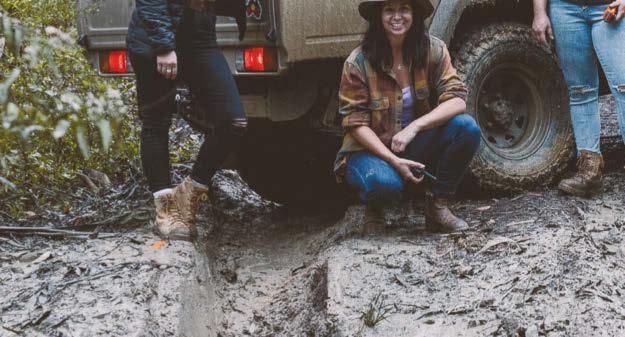







This London-based initiative is surmounting challenges faced by Muslim women in the climbing world
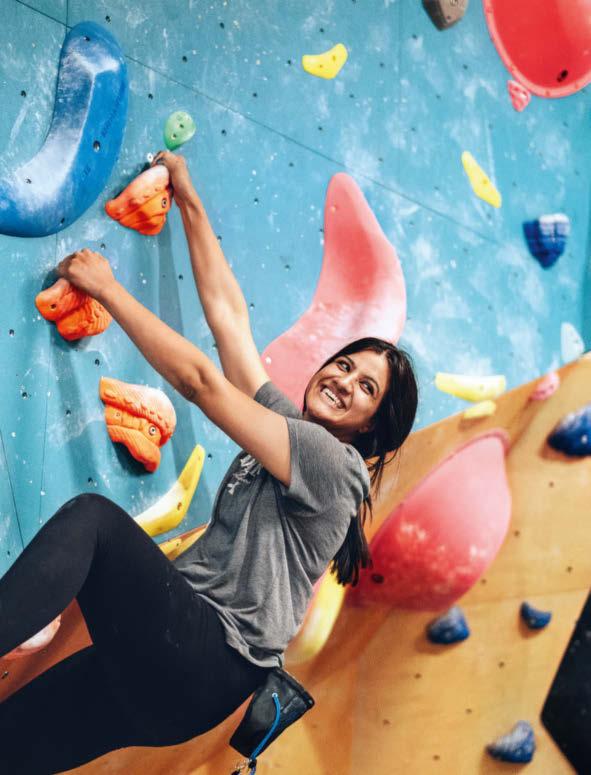
“I do have a fear of falling from heights,” Siddrah Aslam says. This is not exactly what you’d expect to hear from the founder and director of ClimbMuz, a London-based group set up by and for Muslim women interested in climbing. “The thing is,” she continues, “maybe that’s the point.”
When Aslam, 37, is on the wall, everything becomes about problem-solving. “It’s about thinking, ‘I’ve got this fear and that’s OK. How do I take that fear and not let it stop me from getting to the next move?’”
It’s this mentality that has driven Aslam’s success, both on and off the wall. What began almost two years ago as a curiosity for climbing has led to the foundation of a strong –and still growing – community. She set up ClimbMuz as a safe, accessible entry point for Muslim women interested in the

sport, which is often an expensive and male-dominated space. In the group’s infancy, in July 2021, there were just four members, but now there are more than 200, the majority of them climbing novices wanting to try something new.
For Aslam, though, it’s about much more than that.
“What I wanted to show is that there’s a spectrum of Muslim women, not just those who are stereotypically visible,” she says. “We climb with queer Muslim women, Muslim women with tattoos, those who wear a veil…
“As well as practical things like needing a space at a wall to pray, or maybe a chaperone, another barrier [to climbing] these women face is not seeing people who look like them in [that] environment. We wanted to change that.”
It appears to be working. Climbers – from complete novice to advanced – are progressing, becoming friends and crucially, says Aslam, gaining confidence. ClimbMuz currently meets at five walls across London, but it’s hoping to expand out across the UK when the time is right. At present, the group is focused on becoming more visible and educating young newcomers to the sport, as well as setting up more affordable climbs, ensuring easy access to equipment, and encouraging members to climb outdoors.
But there are challenges. Aslam is a trainee educational mental health practitioner by day, so running ClimbMuz takes up much of her free time, and that includes working with other volunteers to source funding. Also, in the climbing community there remain divisions with regards to ability, she says: “We want to create a system where it’s not necessarily about grades but about coming together and rooting for each other.
Regardless of whether you’re a zero hero or climbing a V3, we can all learn from each other.”
For Aslam, it all comes back to problem-solving: “Whether that’s how to safely descend a wall, or creating a safe space for Muslim women to be in a familiar environment. The fear we talked about – it’s always a part of you. It’s about how you internalise that. How are you going to deal with the climb ahead?”
Instagram: @climbmuz_c.i.c

Teflon Sega isn’t like other R&B musicians. This much is obvious from his gravity-defying black-and-pink hair and his purple skin. But there’s another, bigger difference: he only exists in the metaverse. The 2D anime singer, who has almost half-a-million monthly listeners on Spotify, more than 21 million YouTube views and 5.6 million SoundCloud streams, is an entirely digital creation.
The invention of an anonymous musician and visual artist, Sega’s music and online presence show how the lines between the virtual and physical art worlds are no longer clearly defined. Sega, who achieved viral success in 2016 with his breakout single Beretta Lake, interacts with fans through online videos set in a purple-hued dystopian world, as well as on social media and in virtual concerts. “My dream is to have a fully touring holographic augmentedreality live show,” he says. “That’s what I imagine when I close my eyes.”
The Red Bulletin peeked behind the virtual curtain and spoke to the artist behind the metaverse mask…
the red bulletin: You’ve just released your debut album, Welcome to The Mourning Show How was the creative experience?
teflon sega: I’ve been releasing singles since 2016, but I hadn’t thought about doing a whole album until the last year. The experience is so different. With singles, you can easily tell one story in a few minutes, whereas an album lets you show a lot of different sides to a story. This was a chance to explore and show my brighter and more up-tempo sides.
Why did you decide to create music within the metaverse as the digital avatar Teflon Sega?
I haven’t really had the opportunity to tell this story before! It’s been a long, weird journey. Years ago I was signed and then shelved on a major label, and they wouldn’t let me off. First I tried leaking music on to Soundcloud, but that didn’t work. I became depressed. I was in the worst period of my life because I couldn’t express myself creatively. So I created an avatar and started releasing music secretly behind it.
It started as a loophole to get around a contract?
Yeah. The success was amazing – one song charted at number four on Spotify’s global viral chart – but I was still under contract. I didn’t know if the label were going to find out and sue me. They ended up dropping me, thankfully. Then they reached out to Teflon Sega, saying they were interested in signing him. Hilarious.
Did you consider dropping the avatar once you’d been released by the label?
I really did. In 2018, I told my audience that I was going to do a face review, and I announced a date. But I was flooded with messages saying the exact same thing: “Don’t do it, don’t ruin something special, don’t ruin this escape…” That changed everything. It made me realise this story was now bigger than me. My job now is to breathe as much life as I can into Teflon and this unique situation. I’ve unearthed an entire new passion, which is world-building and storytelling within music and the metaverse.
How did you learn the skills to create your real-time animations?
I have no background in 3D art or in animation or technology. I really learnt everything on YouTube and found a few mentors online who helped me and held my hand a bit. I was pretty obsessive, doing it for 15 hours a day, every day. It was a painful learning process, but within a few years I started feeling more confident. I put out a lot of cringey content in the process and learnt in front of my audience. I feel like I’m still learning.
Recently you posted a side-by-side comparison of a motion-capture music video and the creative process behind the scenes. Why did you decide to show that now? It’s something I’d wanted to do for a long time. Animation as an art form is more than 100 years old, but realtime animation and motion capture is so new and it’s becoming accessible for creators in their homes, without studios or big budgets. People would send messages complimenting my ‘team’ on their work. I wanted to show that I’m just making this stuff in my garage, and that you can do it, too.
Do you feel like a different musician because of your avatar? I do. It’s been beautiful. In the process of what you could call a gimmick, or kind of corny, I’ve really learnt that avatars are just a new version of what’s always existed in art. History is full of anonymous creators; there’s a plethora of artists from the past who felt that by putting on a literal mask, they could remove a metaphorical one and express something that was a little risky or a little more real. When I started making music as an avatar, I was able to express sides of myself – my depression, my anxiety, some of my quirks – that even the people around me had never seen… My audience connected deeply with them, and it was freeing. I think that’s the experience of a lot of introverted artists. So avatars are going to become a big wave in the creation of art in the future. Instagram: @teflonsega
Teflon SegaCreated as a means of outsmarting the music industry, this 2D anime singer ended up pushing the boundaries of artistry in the metaverse

“My job now is to breathe as much life as I can into Teflon”
This Australian free surfer has no interest in fitting in. With her new company, Pussy Surfboards, the 25-year-old is creating a counterculture scene in the swell
Words LOU BOYD Photography LUKA RAUBENHEIMERAll surfers have their own individual style, but few have quite as much of it as Jaleesa Vincent. The 25-yearold pro surfer, based in Byron Bay, is internationally renowned for her creative and unconventional flair, both on and off the board.
Pegged as a rider to watch since her teens, in 2015 Vincent entered the competition circuit, where she stood out with her self-assured and alternative riding. But her competitive surfing career was short-lived; by the age of 20, she’d retired from the Qualifying Series (QS), asserting that competing didn’t align with her surfing style or life goals. “At the time, it felt like giving up on my dreams,” she says. “But deep down I knew it wasn’t the path to true happiness.”
Instead, Vincent chose a path that no female pro surfer had taken before. She began directing and animating her own surf films, making and selling art, and heading punk band Cupid and The Stupids, all while surfing waves of her choosing. The industry paid attention, and before long Billabong sponsored her as an official ambassador.
Now, with her new board brand, Pussy Surfboards, Vincent is providing an alternative to the limited women’s options offered by the mainstream, to inspire others to surf in their own way, too. “Pussy is a potion of: tan lines, individuality, ingrown hairs on bikini line, nip slips, charging, glamorous as hell, tap nose, tomboy, princess, zero fucks, goth, fairy,” she declares on the brand’s website. “Call me a pussy, I dare you.”
the red bulletin: How did you first get into surfing?
jaleesa vincent: Growing up as a grommet [a young surfer], I surfed with my older brother and followed him and his friends out into the water. Then I did a couple of QS comps and travelled around the world.
You gave up competitive surfing before your early twenties. Why? I never really liked comps much. I hate how you’re judged, and honestly I don’t think you can judge surfing. I always came in from every heat thinking, “That’s fucking bullshit.” It was never fun for me, and the whole world just made me so anxious. I love surfing, and I felt like I wanted it to be my career, but I just knew I had to walk away from that side of the scene and do my own thing.
As well as a surfer and filmmaker, you’re an artist, animator, dancer, poet, musician, and even a taxidermist. That’s a lot of jobs… I think it’s just the way my brain works. My music, painting, poetry and filmmaking is all under the same umbrella in my mind. They help each other out and inspire me to go on to the next thing. I’ll do one project and feel inspired, so they’re all connected.
What was the inspiration behind Pussy Surfboards?
When I started surfing, I always had an older brother or a boyfriend who would help me get the right board, but if I hadn’t had those people I wouldn’t have known where to start. It’s hard to know what kind of board variant to choose, and if you don’t start on the right one – say, if you
start on a really short board and with no paddle power – it can put you off surfing for ever. That made me think that it’d be cool to start a surfboard company where I can make boards that inspire people to go surfing and not be afraid; to be the girl in the male-dominated space who other girls can come to. The power of Pussy!
Have you always known that you wanted to make your own boards? Absolutely not. It was just an idea, but the cat got out the bag, then it turned into a tiger, then it turned into a Pussy surfboard and refused to go back into its bag. I couldn’t stop thinking about this chance to have my own company where I can use all my creative ideas and put them out exactly as I want.
Do you shape the boards yourself? I work with an anonymous shaper who is my fairy godmother and is showing me the way. I started shaping some boards during COVID, and I came up with the Britney design, which is one of the four that have come out so far. But it’s stepping stones [right now]. I still have so much to learn.
Where do you see Pussy Surfboards going in the future?
I want to make some cool films as a brand and get some cool girls on my surfboards… Actually, I want girls, boys, anyone at all who feels like they resonate with the Pussy vibe. The dream is to make enough money that if I see girls out in the water doing her own thing, I can sponsor them and support some up-and-coming new riders, take them under my wing and make a rad Pussy Surfboards crew.
Why do you think your vibe is so different from the rest of the surfing world?
I hang out with a lot of people like me, so I don’t always see it. But I guess the surf industry is so serious. I always just wanted to make my own corner that’s a bit funnier, a bit more silly and stylish.
pussysurfboards.com

“I wanted to make boards that inspire people to go surfing and not be afraid”Naomi Schiff
The racing driver turned F1 presenter on inspiring a new generation of motorsports fans, being backed by Lewis Hamilton, and almost killing Daniel Craig
Words ISABELLE ARON
Naomi Schiff first tried go-karting at a family friend’s birthday party at the age of 11 and was instantly hooked. Initially, though, Schiff had been wary of racing: born to a Belgian father and a Rwandan mother, she’s mixed-race and didn’t see anyone else at the track who looked like her.
“There weren’t many girls or people of colour,” says Schiff, now 29. “I didn’t feel like I fitted in, and the idea of being compared with my counterparts was frightening.” But after some tough love from her dad – himself a racing driver before she was born – Schiff went for it. “By the time I climbed out of the go-kart at the end of [my first] race, I was smiling from ear to ear,” she says.
By 14, Schiff was representing South Africa – the country where she grew up – in the Karting World Championship. She has gone on to race in tournaments including the Clio Cup China Series, which she won in 2014, and the all-female W Series. She also worked as a stunt driver on the movies No Time to Die (2021) and Jurassic World: Dominion (2022). But, despite her successes, Schiff says it’s been no easy ride as a Black woman with limited funds in what’s still a very expensive, white, male-dominated industry.
She has now turned her attention to presenting, as an F1 analyst for Sky Sports and co-host of its YouTube show Any Driven Monday. It’s a move she hopes will encourage more women and girls to take up motorsports. “If little girls turn on the TV, they’ll see my face,” she says. “If I was wearing a helmet, they probably wouldn’t.”
the red bulletin: What’s the big appeal of motorsports for you? naomi schiff: When I was 11, me and my dad built our own little racing team, and I spent hours on the track at weekends. The art of driving fascinates me. It’s exciting to see F1 teams, engineers, mechanics and drivers go head-to-head, thinking about every minute detail, giving it everything they’ve got to be the best on the track.
What are the barriers to making it in motorsports?
It’s incredibly expensive. Often in racing there’s the attitude that if you’re quick enough it won’t matter. But to be quick you need time in a car, and that takes money. You can’t just jump in a car and drive the wheels off it. That’s like saying to Usain Bolt, “Don’t run all year, just rock up to the Olympics.” For women, being taken less seriously than the men is a barrier, too. I spent a year knocking on doors with my business card. Had I been a man who looks like a typical racing driver, I probably would have had more calls.
What changes are needed?
F1 is more popular than ever. Your average motorsports fan was typically a middle-aged white man, but that’s changing. There are young women and people from diverse backgrounds watching, and they need to be catered for. Space also needs to be made for women. There’s an institutional issue: a woman hasn’t raced in F1 since 1976. We need young women and their parents to see female role models in the sport. We’re not trying to make it easier for the women; we’re trying to make it equally hard.
You experienced trolling last year after joining Sky as an F1 pundit. How did you deal with that?
It was scary. Suddenly, all this attention was on me. People were discussing whether I deserved to be in that environment. One person tweeted, “Can you guess why Naomi Schiff got her job?” There were 250 comments from people suggesting why I got the job, whether it was the colour of my skin or that I’d fucked my way to the top. It was either misogyny or racism. I responded in the calmest way I could, with three yawn emojis. I went to sleep and woke the next day to a notification that Lewis Hamilton had retweeted it and stood up for me. I was incredibly grateful. The one thing that’ll make you feel better in a moment like that is having the support of your peers.
How does stunt driving in movies compare to racing?
On my first day on [No Time to Die], Daniel Craig walks into the room and says, “Hi, I’m Daniel.” I thought, “Oh my God, I’m very aware of who you are!” The stunt I did was with Daniel – he likes to do a lot of them himself. He had to cross the road and I had to slam on the brakes and stop just in front of him. I thought I was going to take him out! I was concerned there’d be a headline saying “Racing driver kills Daniel Craig”. There’s a massive buzz to stunt driving, but I prefer racing – it’s much more in your hands.
Any advice for those wanting to break into motorsports but worried they might not belong?
If you walk into a room and there’s no one who looks like you, whether that’s in motorsports or sport or business, it has no bearing on your own capabilities. It might be harder, and people might not understand your struggle, but that doesn’t mean you can’t do it. Don’t stand in your own way – other people will do that. Go for anything you want to do.
Naomi Schiffis
a Formula 1 presenter and analyst for Sky Sports; Instagram:@naomischiff
“We need to see female role models in Formula 1”

Skating the hallowed halls of London’s Natural History Museum was a feat reserved for fantasy – until skate ace LETICIA BUFONI invited a crew of women skateboarders inside for a once-in-a-lifetime session…
Words JESSICA HOLLAND

 Close to the bone: Aldana Bertran clears a velociraptor, nailing the right velocity to rapturous applause
Close to the bone: Aldana Bertran clears a velociraptor, nailing the right velocity to rapturous applause
It’s almost 1am inside the Hintze Hall of London’s Natural History Museum, and the usual shadowy silence of night has been broken by a crew that’s here to realise an unlikely ambition. Beneath the unmoving gaze of Charles Darwin’s marble likeness, Brazilian pro skateboarder Letícia Bufoni stands at the top of the instantly recognisable double staircase, psyching herself up to kickfip over a dinosaur skeleton.

A long ramp has been set up over the 21-stair set, with a kicker at the bottom to send her soaring into the air. This Victorian landmark with its mosaic foors, carved pillars and vaulted ceiling, from which the bones of a colossal blue whale are suspended as if mid-dive, is not the sort of place where a bunch of skateboarders would typically be left to run wild. As Bufoni says, “Skateboarding is known for breaking stuff. This is one of the craziest experiences of my life.”
Even without worrying about smashing priceless relics, it’s a diffcult trick. The roll-in is steep, the foor slippery, and precision is needed as well as speed. But if anyone who can pull it off, it’s Bufoni, who’s at the forefront of an evolution Darwin couldn’t have fathomed.
Bufoni has pushed the limits of not only women’s skateboarding but the sport as a whole. The 30-year-old began skating in São Paulo at the age of eight, went on to win six X-Games medals, and broke
Letícia Bufonirecords in 2022 by grinding a rail out of a plane fying at 2,750m with a parachute on her back. The crew of skaters, flmers and photographers assembled in the museum for this unique night-time session hold their breath as she whirrs down the ramp and into the air, appearing to foat as the board spins beneath her. When she lands cleanly and rolls away, the ecstatic response echoes around the vast space.
“We’re making history out here,” says 24-year-old Filipina skater Margielyn Didal. A close friend of Bufoni, Didal competed in the Olympic street skating fnals in 2021, where she won hearts for the excitement and encouragement she showed towards her competitors. Tonight she’s recovering from an injury and is unable to skate, but still radiates positive energy. “It’s insane!” she says. “Who’d let you skate inside a museum?”
Bufoni helped mastermind this oneof-a-kind event, landing gnarly tricks in close proximity to prehistoric treasures over four long nights in London. Fellow skate professionals and Olympians Lore Bruggeman (21, from Belgium) and Aldana Bertran (24, from Argentina) are also here, performing feeble grinds on the rail outside the museum’s entrance, and nose slides on a bench in the minerals gallery. “It’s a beautiful place,” says a wide-eyed Bruggeman as she takes it all in during a pause in the action.
“The architecture is amazing.”
“This is one of the craziest experiences of my life”
Letícia BufoniPATRIK LUNDIN
Having free run of this iconic 142-yearold venue has made the plane ride over a worthwhile journey, but England wouldn’t usually top a list of dream skate destinations for these pros. To represent the local scene, a crew of infuential women skaters from across the UK have also been invited to skate these hallowed halls on this, the last night of shooting, to connect, get inspired and demonstrate the vibrancy of the community here –which, despite scant resources, is growing rapidly. “I don’t know much about the UK skate scene,” says Bruggeman, “but it seems very close and very inclusive. And there are some rad skaters.”
Like Bufoni, many of these UK-based skateboarders are in their thirties, grew up as the only girl skating in their local scene, and have played a major role in shifting this status quo. While Bufoni moved to the global skate capital of LA at 14, however, these women carved out space for themselves and others like them in cities such as Leeds, Sheffeld, London and Milton Keynes, making the most of janky pavements, bad weather and grimy, repurposed skate spots. This opportunity to come together and shine a spotlight on women’s skating against
a grand backdrop is both a celebration of how far things have come and a fresh demonstration of what’s possible with the right support.
Danni Gallacher is wearing a T-shirt that reads ‘Plants and Skateboarding’, which helpfully sums up the interests of the 35-year-old gardener, skate coach and event organiser based in Sheffeld. She’s doing kickfips in front of a fossilised mastodon with enormous tusks as Stefani Nurding – skateboarder, model, fashion infuencer, and owner of Salon Skateboards – flms on her phone. As founder of the organisation Girl Skate UK, Gallacher has spent the last decade helping female skaters fnd each other,
gain visibility and develop their skills. “Tonight it’s like, wow, we’re in the Natural History Museum!” she says. “There’s a mammoth skeleton over there! This is pretty incredible! And Letícia’s a really, really sick skater.”
All-female skate projects like this one, supported by big brands and documented in order to inspire others, are still rare in 2023. But for those who started skating decades ago, it’s even more meaningful to see a group of women grab this kind of once-in-a-lifetime opportunity. Gallacher was 15 when she frst picked up a board, the only girl among a group of boys who’d skate in their school car park in Kent at weekends, and she found it hard to stay motivated. “I didn’t know any other girls,” she says, “and I didn’t know how to get good, so I just stopped.”
This was 20 years ago, before people could fnd each other on social media, and before you could look up trick tutorials on YouTube. There were a couple of prominent female skaters in the UK, but unless they skated at your local park or you picked up the right magazines you might not hear about them. When she was 20, Gallacher took up skating again. This time around,

This event is a celebration of how far women skateboarders have come
 Giant leaps: Sheffield-based skater Danni Gallacher is the founder of the organisation Girl Skate UK
Giant leaps: Sheffield-based skater Danni Gallacher is the founder of the organisation Girl Skate UK
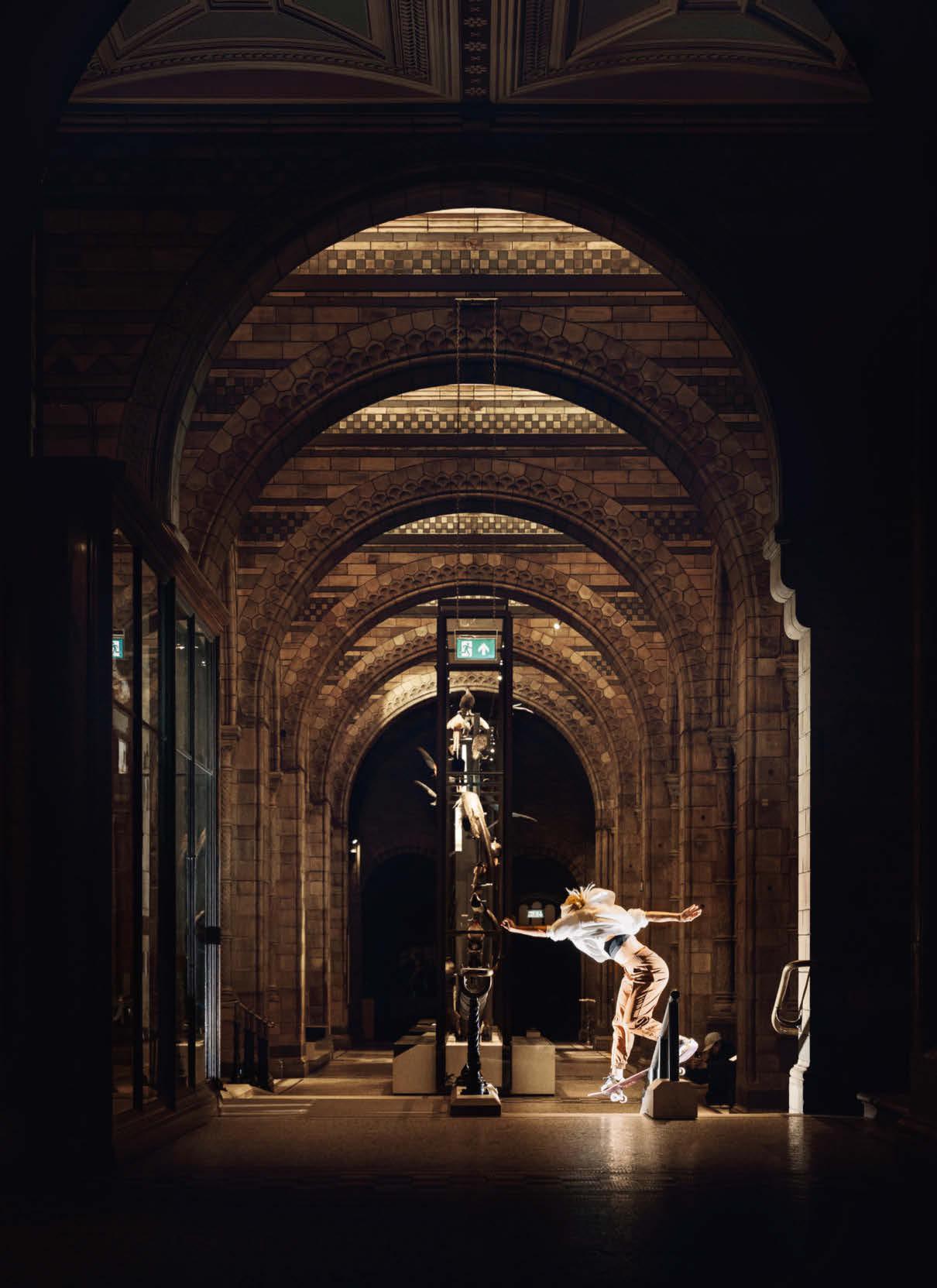
“To inspire the young generation to skate is amazing”
Letícia BufoniShining example: Bufoni (pictured) has won gold medals in all the big competitions, making her a very visible inspiration to young women skaters
When Lorenz Holder, who shot this month’s striking cover image, entered the Natural History Museum, it took a while to adjust. “For the first five minutes, you’re just like, ‘Wow, this is crazy,’” says the Munichbased photographer. “My passion is combining actionsports photography with unique spots or unusual architecture, so this shoot was a perfect fit. Never in my whole career have I seen someone skateboard in a location like this.” Everyone on site became nocturnal for four nights, with the four pro riders clocking up more than 80 hours of skating over the four sessions, between 10pm and 4am. With so many tricks for the skaters to try all over the museum, Holder had to ensure he was always ready. “It was chaos. We had around five minutes on each spot and it all came down to a crunch time. I was shooting on a Canon R5 with a 24-70mm lens because, for me, a camera is like a tool is for a construction worker – the more natural it feels, the more creative you can be and forget about the technical stuff. [In the cover shot] Letícia is doing a kickflip over the dinosaur, so [nailing it] was a combination of her doing the perfect trick and me getting that perfect timing. It’s an awesome feeling when you see it on the display and everything is perfect. It's like pure joy.”

a chance encounter lit a spark, proving the difference that visibility can make.
On a trip to a skatepark outside her hometown, Gallacher saw Lucy Adams, one of the frst female British pros and now progression project lead of Olympics governing body Skateboard GB. “I was too scared to talk to her,” she says, “but when I got home I Googled ‘girl skater’ – and this is when the internet wasn’t really massive – and found out about a Rogue Skateboards event.” Rogue was a brand with an all-female skate team launched in 2005 by Hertfordshire-based pro skater Jenna Selby, who had also been running annual ‘Girl Skate Jams’ since 2002. “I begged one of my friends to drive us there, and that’s where I met girl skaters for the frst time.”
Among those who Gallacher met at that frst, life-altering event was Georgie
Winter, who skated for Rogue in her teens. Today, 15 years later, Winter is here at the Natural History Museum. “I actually don’t know how to describe how insane this is,” she says as pizza arrives to keep everyone going. “We’re here in the hall with the whale.”

Once Gallacher found other female skaters, she threw herself into the community, contributing event write-ups to the website Skater Girl, then launched a site herself in 2014 to collate news about upcoming events in the women’s scene. She called it Girl Skate UK and created an Instagram account of the same name soon after. By sharing content from female skaters of all levels around the country, it enabled them to be visible to each other for the frst time. “Social media played into this community aspect of skateboarding that never existed before,” Gallacher says.
With this platform in place to get the word out, Girl Skate UK began hosting events and launched a ‘Community Connect’ programme to encourage the formation of more regional collectives. The impact on the women’s skate scene was huge, says Winter: “Rogue did videos and tours that other skaters could

“No one can tell us we’re not relevant”
Stefani NurdingChecks and balances: Bufoni examines a surface to see if it’s fit for riding
look at, then Danni created something you could be part of.”
Both sides of this coin are important in pushing women’s skateboarding forward. Pro skaters such as Bufoni, Didal, Bertran and Bruggeman – who are now messing around, skating two boards stacked on top of each other and wheeling each other around on a stack of gym mats –push the limits of what others consider possible. They’re all competitive skaters from very different corners of the world, most of whom made it to at least the semi-fnals of the street skateboarding event at the Tokyo 2020 Olympics.

Bufoni, in particular, has also broken new ground in other ways. From her beginnings as a skater in São Paulo at eight – like Gallacher, standing out amid
a sea of boys – she moved to LA as a young teen to further her career. Along with the gold medals from every big competition – World Skateboarding Championship, X Games, Street League Skateboarding –she became the frst female skater to sign for Nike, later appearing in Gizmo, the brand’s frst all-female skate video. Bufoni is also a playable character in the video game Tony Hawk’s Pro Skater 1+2 and has co-launched a skate brand with young Team GB star Sky Brown named The Monarch Project. But starting out wasn’t easy for the Brazilian, either.
“When I began, 20 years ago, I was pretty much the only girl skating in my neighbourhood,” Bufoni says as she rests on a large mat in the Hintze Hall. “It was hard to convince my dad that
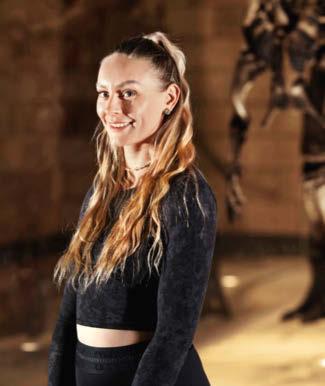 Rail blazers: (from left) Leeds-based skater Izzy Almond performs a 50-50 grind; Bufoni treats a croc to a nose grind
Rail blazers: (from left) Leeds-based skater Izzy Almond performs a 50-50 grind; Bufoni treats a croc to a nose grind
skateboarding wasn’t just for boys. He hated me skateboarding – he took my frst board and broke it in two. So, throughout my career, my goal has been to be someone who little girls can show their parents and say, ‘Hey, I want to be like her.’ Being that person today, inspiring the young generation [to start] skateboarding… it’s amazing. And of course, there were a lot of girls who started way before me, but at the time there was no internet. No Instagram. No YouTube. Nowadays, with social media and everything, it’s easier. I just hope I can keep inspiring more girls and doing what I love the most.”
Bufoni’s highly visible career has already made a big impact, not least on the UK skaters here today. “She showed you can do it all,” says Rachael Sherlock,
who is flming the action at the Natural History Museum with her partner Aurore Roussel; together they run a communityinterest company named Keep Rolling. “You can be an athlete, model clothing, do ads, ollie over a Porsche. No one else was living that lifestyle as a female skater at the time. It’s on another level.”


Closing the pay gap between male and female skaters is one way to encourage a new generation of girls to push skating
to its limits. Nurding sees social media as playing an important role in this: “It’s a way of the girls getting some power back. We’ve been told for such a long time that no one was interested in seeing women skating. Now, no one can tell you you’re not relevant when it’s obvious you are.”
A former competitive skater and model for Vans, Nurding pivoted towards building her own brand after having a child, who’s now four. Now, she has a six-fgure following on both TikTok and Instagram, where she posts updates on new releases from Salon Skateboards, as well as ftness and fashion content and skate clips. Her sense of style is unapologetically feminine – think glitter grip tape and skating in a mini-skirt –despite the abuse she’s received for
“We’re making history here”
Margielyn Didal
expressing herself online. “I think [Stefani] is inspiring,” Gallacher says. “She’s a single mum, she runs multiple businesses… There’s no stopping her.”
Competitions and sponsorships help support skaters dedicating their life to doing what they love and reaching their potential. Building grassroots networks, on the other hand, as Gallacher has done, has urged on the evolution of women’s skateboarding in a different way, from the bottom up rather than the top down. In recent years, she has launched a Girl Skate UK Community Fund to help people in regional collectives around the country. She has also launched a skate summer camp for trans and non-binary adults, held in a patch of woodland in Norfolk, which involves activities such as wild foraging, guided meditation, massages and campfre-cooked meals.
“We still need spaces just for genderminority skaters, because it helps them frst gain confdence and get into the skatepark,” Gallacher adds. Once this confdence is gained, she hopes, these skaters will feel comfortable taking up space as part of the wider scene rather than staying segregated. “For me, the main aim for Girl Skate UK was always for there eventually to be no need for it.”
Over the past decade, things have been progressing fast, particularly
during lockdown when many women with time on their hands rediscovered skating or grabbed a board for the frst time. At 23, Izzy Almond is one of the younger skaters at the Natural History Museum event, and, as others buzz around excitedly, she’s patiently immersed in a battle to 50-50 the rail that’s been set up around a raptor skeleton. Almond has only been skating for three years, but the extent to which she has already immersed herself in this creative skate subculture refects the progress that’s been made.
An illustrator and graphic designer who graduated last year from Leeds Arts University and skates with a mixedgender crew, Almond has put on events in the city for female and non-binary skateboarders, of which she says there are hundreds. She also has a part-time job at Welcome Skate Store in Leeds. “It’s good to have a shop that’s so inclusive and that creates a community,” says Almond, who’s currently working on a video part.

“Working there has given me so many opportunities. It’s nice to have that base.”
It’s the kind of situation that some of the older skaters present would have dreamed of at the same age. Of course, not every UK location is an equal-access skate utopia. Almond grew up in Hull, where she didn’t see as many female skaters; she thinks she may have started earlier if she had. But, for all the extant inequalities, Gallacher says, “It’s hard to complain, because I’ve seen [the skate scene] from so long ago and it’s come along massively in that time.”
The next stage in the evolution of women’s skateboarding, of course, is happening to skaters who are even younger than Almond. Superstar skater Sky Brown and Cornwall native Lola Tambling, both 14 and in Team GB for the Paris Olympics, aren’t just ‘good for girls’, a common backhanded compliment. Tambling began at seven; Brown has been skating from three, and was competing internationally at eight. They’re members of perhaps the frst generation of girl skaters to fully close the skills gap between themselves and their male counterparts.
“It’s such a collective thing,” Gallacher says when asked if she ever takes time to refect on her role in this movement. “I may have started a little website that spurred it on, but it’s everyone involved, everyone who’s made a community and spread it. That’s what’s important. It’s never about just one person.”
As the night gives way to day, a few of the women are busy getting their last clips and swapping contact details. But staff are already starting to pack away the obstacles, ready to erase all trace of this unlikely night session before the frst museumgoers arrive at 10am. A gaggle of skaters is forming by the exit. “This was a unique experience,” Bruggeman says. “It’s a sure thing I’ll never forget it.”
As the crew wanders down the steps of the museum’s main entrance, the only traffc on the street is an empty tourist bus. The moon is still huge, and the terracotta walls of the Victorian museum are lit up. Everyone’s still on a high from the surreal, one-of-a-kind session, and everything on the street looks like a skate feature. “Kickfip out of the back of that lorry!” someone calls out. “Feeble that handrail!” The collective energy is effervescent. It feels like the city is theirs. Watch the full film on the Red Bull skateboarding channel on YouTube
“I’ll never forget this experience”
Lore Bruggeman


Chicago folk singer and poet KARA JACKSON writes songs of love and loss. Sounds bleak? On the contrary, her debut album is a testament to the endurance of the human heart
Words DAVYDD CHONG Photography ASH DYE
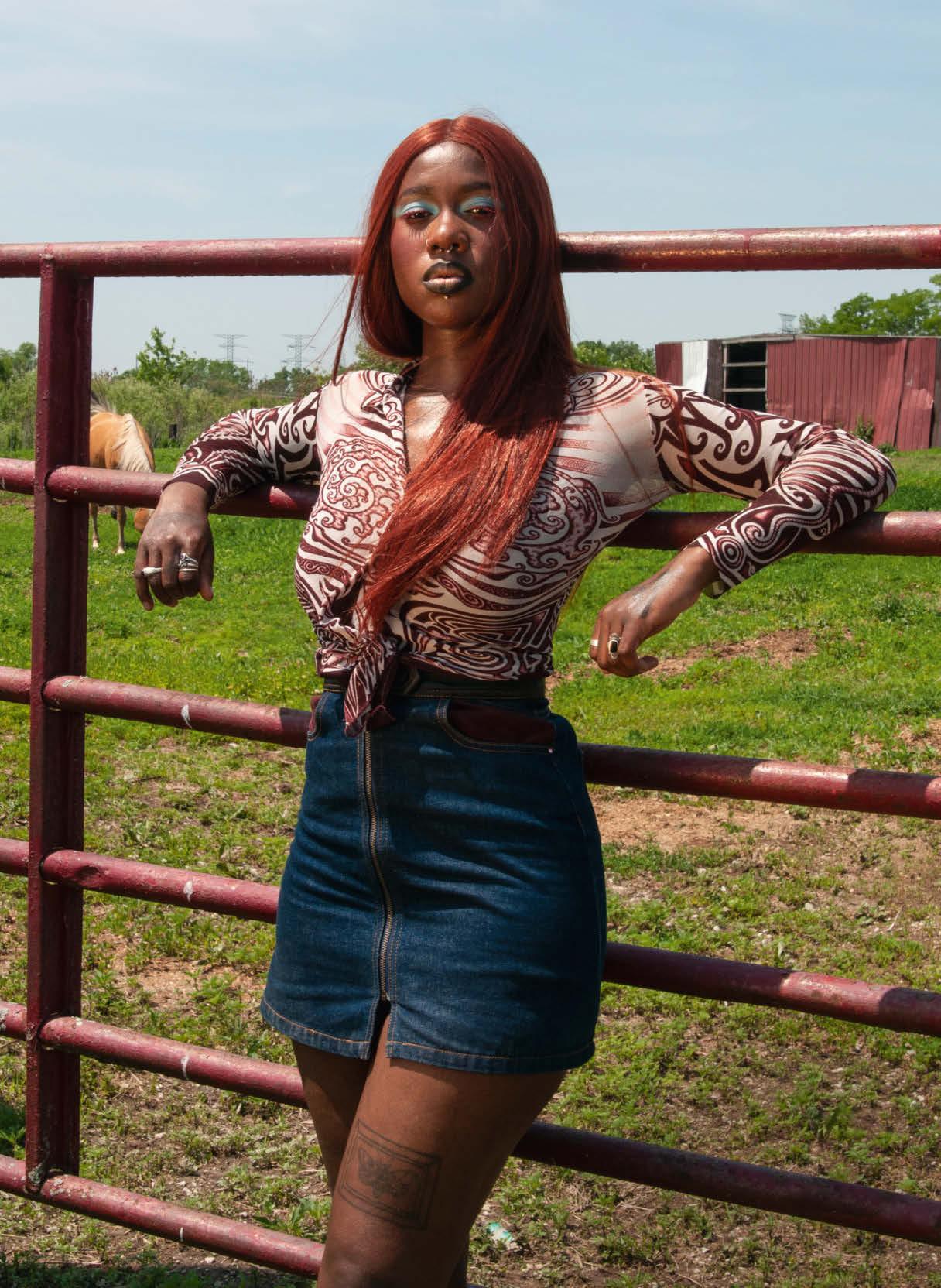 Stable position: Kara Jackson, photographed for The Red Bulletin at the inclusive, non-profit Broken Arrow Horseback Riding Club in Chicago in June this year
Stable position: Kara Jackson, photographed for The Red Bulletin at the inclusive, non-profit Broken Arrow Horseback Riding Club in Chicago in June this year

ara Jackson is pretty top-notch. It’s right there in a lyric on the 23-year-old singer/songwriter’s astonishing debut album, Why Does the Earth Give Us People to Love?, a profound yet witty, blunt yet vulnerable meditation on love, grief and the frustrating tangle that is the human condition.
Informed by the soundtrack of her childhood home in the Chicago suburbs – jazz, soul and, most evidently, folk and country – it’s an aural odyssey that constantly surprises and confounds. The haunting guitar melody of No Fun/Party takes a tonal detour mid-song and ends in a lo-fi ukulele lament; Dickhead Blues morphs from sparse, wry put-down to yearning choral crescendo, then back again.
But the most potent weapon in Jackson’s arsenal is her voice – a rich, resonant alto – and what it has to say. Like the shrapnel of grief she details in her songs, her lyrics cut deep and then endure. “Isn’t that just love… the will to destruct,” she ponders on No Fun/Party. The album’s unbearably moving title track was inspired by the death of her best friend from cancer in 2016: “At the age of 17, your knees were weaker than a sheet,” she recounts. “And I was just in disbelief. The sight of you was vanishing…”
Her affinity for words is only to be expected: the daughter of an English teacher, she recently majored in English language and literature, and in 2019 she was named National Youth Poet Laureate. Of the award, however, Jackson sounds almost regretful: “In retrospect, I don’t know if I really identify that much with that role. Of course, it was such an honour, but I was 19… I’m not sure I feel like that same person any more.”
Some of the songs have an equally distant provenance. Gestation was protracted: rough demos were committed to tape in 2019 but lay in a COVID-induced stasis for two years. Her local musician friends – R&B singer/songwriter KAINA, multi-instrumentalist NNAMDÏ and jazz-rap artist Sen Morimoto – helped bring these to maturity in the studio in 2021. The fleshing-out process was organic and at times left-field: a church-bell chime on Dickhead Blues; the revving of Morimoto’s car engine on Rat. Why Does the Earth… was finally released to the world in April this year.
“It feels really weird,” Jackson explains, “because something I dreamed about doing literally my entire life is materialising in front of me. And it’s such a long game – like, you get an inch and then there’s so much more to go.”
Pretty top-notch, for sure. And potentially a generational talent.
Kara Jacksonthe red bulletin: Your lyrics have a disarming openness and honesty. Is that a personality trait?
kara jackson: [Laughs.] I’ve always been a very blunt person, even as a child. I went to a religious pre-school, and my mum says that one day I went up to my teacher and was like, “Why does God kill so many Brown and Black people?” I was, like, three at the time. I guess I’ve always asked questions that maybe make people uncomfortable. I think that sometimes it makes my life harder; sometimes I have to take a longer route or, you know, people won’t get it. But it’s also really rewarding in the sense that you reach people who really needed those words. Like, people listening to the album have told me, ‘I’ve been thinking about grief in this way, too.’ That’s been really rewarding, for me to use my bluntness to perhaps communicate for someone else.
Grief and its relationship to love is an overarching theme of the album… It’s a connection I’m always grappling with. It feels symbiotic to me, the way
love and grief are processes that inform one another. I think of grief as the only affirmation we have that we’ve been loved and we got to love someone. Also, with this album I’ve learnt how necessary expressions of grief are in order to inspire expressions of love. Like, I think there’s a sense of purpose you get when you lose someone. On the flipside, you could choose to be cold and not love anyone at all. [The late Black feminist writer] bell hooks talks about how we live in a loveless culture. There’s a chapter in her book [2000’s All About Love: New Visions] where she talks about grief and how it’s the most pronounced form of love. That’s something I try to consider in my work, too.
The album’s title was born from a very personal experience of grief, wasn’t it?
Yes, I started writing the title track a year after my best friend Maya passed away – I was, like, 18. When I went to sit down to make the album years later [in early 2021], there was a sense that I was returning to the song with a different perspective. People say you don’t ever grow out of grief, you just grow around it; that you learn to live with it and use it as a vessel. I was coming back in my early twenties to a question I’d asked in a more naïve place – a place of agony and frustration as a teenager – and trying to make more sense of it. I think that’s why I wanted it to be the title of the album, too. It’s born out of grief, of course, but also there are so many types of grief. As much as the question asks
Why Does the Earth Give Us People to Love? in the sense that you could lose a person, it also appears on the album in a more frustrated way, like with lovers and all that drama: “Oh, why do I have to deal with people?”
What was your songwriting process?
The songs started out as just me and my guitar. I recorded these rough demos in my room, and I was really paying attention to the lyrics. Because writing the words takes effort. I wrote Curtains while I was on a plane –when I talk about curtains in the song, they’re the ones that were hanging in front of me on the plane – but that doesn’t happen that often. A lot of the time, I really have to work at it, sit
with the melody and be like, “Please, I hope I come up with words for this.”
When did you first discover your incredible voice?
I don’t know. I’ve always loved to sing – me and my brother would sing little jingles and theme songs around the house – but I don’t think anyone took it seriously. It was in third grade, I think, when people were like, “Ohhh…” I’d go to my friend Elsie’s house and we’d put on concerts with our Barbies. She was one of the only people who knew I could sing – she’d make me sing the parts for her Barbie sometimes. We had block parties all the time, and one year there was a band with an open mic. Elsie was like, “You have to sing,” and dragged me out of her house. So I got up and sang A-Tisket, A-Tasket [a traditional nursery rhyme, adapted by legendary jazz singer Ella Fitzgerald in 1938]. Two of my neighbours played in the Chicago Symphony Orchestra and the Lyric Opera, and they emailed my mum the next day saying, “Your daughter can really sing.” I got my first guitar in maybe fifth grade and started out playing other people’s songs – a lot of The Beatles’ songs, actually. A friend had this little art gallery and was like, “You can play the gallery if you want.” I was 12 or 13 and got little tips, I think. Then, with time, I came to understand my voice as an instrument.
What was it like growing up in your Chicago suburb?
Oak Park [the birthplace of writer Ernest Hemingway and one-time home of architect Frank Lloyd Wright] is an interesting place because it’s one of the only suburbs in the States that was intentionally integrated. It was an experiment in diversity and inclusion and had a reputation for that, [though] when you live there it’s a bit more complex. Growing up, I was quite weird, a loner sometimes. I’ve always had friends who are dear to me, but maybe not that many. I’m someone who’s always stuck beside the weird kids. And I’m really close to my older brother, so I would hang out with him a lot. I spent a lot of time in middle school on the internet, on Tumblr, because I had friends online. I think that’s how I started learning so much about people of different cultures. Even in high school I was known as ‘the
“I’ve learnt how necessary expressions of grief are in order to inspire expressions of love”
 Kara Jackson
Kara Jackson
when I was five. My dad is a huge jazz connoisseur, and my mum was a soul person, but they also loved [Black country star] Charley Pride and [folk singer] Jim Croce. And then my older brother had the contemporary influences – that’s how I got into hip hop like Wu-Tang [Clan] and Three 6 Mafia. As a teenager, I also got into people like Laura Marling, Bobbie Gentry and Nina Simone, who always called herself a folk artist. I was captivated by the way that women like her and Joni Mitchell and Joan Baez and Buffy Sainte-Marie took up space with their performances. They were holding their own, on stage alone. Just seeing women with guitars, I think I always wanted that for myself.
So your musical direction was never compromised?
poetry girl’. There’s always been this distance between me and people. My mum would see other high-schoolers at the bus stop and be like, “Oh, do you know my daughter?” And they’d be like, “Oh yeah, we do… but don’t tell her we talked to you.” I’ve learnt to appreciate the quality of my friendships over the quantity. And that I don’t get along with everyone because I don’t think I want to. [Laughs.]
Many of your peers wouldn’t have been exposed to much folk and country – what was your musical upbringing like?
My parents always played music. My dad grew up playing the trumpet, and my mum insisted on me and my brother having formal music training, so I started piano lessons
Coming from a scene [in Chicago] with such a rich history of art and culture, where I was performing alongside rappers and poets and people telling stories, I think I never felt I had to be uniform in any type of way. My mentor is [singer and poet] Jamila Woods, and she taught me about embracing your multifaceted nature. I think there are certain standards that come with being an artist who looks like me, and deviating from those standards can seem inaccessible to some people, even though I’m talking about things that everyone complains about. I knew that making folk and country music wouldn’t be the same as if I was, say, an R&B or rap artist. But the first folk singers were farmers, people working on the land, and that’s where I come from, too – my dad’s family are from Georgia. As much as I am a folk artist, most of my peers are rappers and hip-hop artists, so that’s a really big influence on my work as well. And my attention to language and the poetic form… I think the hip-hop form is directly related to that. Even as a folk artist, I’m not making folk music that everyone’s heard. I always embrace my uniqueness. Not everyone is going to get it all the time, but I think the people who do, really do.
Kara Jackson will be performing at the End of The Road festival in Blandford Forum, Dorset, which runs from August 31 to September 3, and at St Pancras Old Church, London, on September 6. Instagram: @karakara

“I’ve never felt I had to be uniform in any type of way”



loves to push himself to – and beyond – the limit
Words PETER FLAX
Photography GIANFRANCO TRIPODO

Wout van Aert is somehow not tired. He recently clambered off his bike after a five-hour ride in the Sierra Nevada mountains of Granada, southern Spain, spinning and churning up 3,500m of climbing in summer-like heat. But let’s not get dramatic; for the Belgian professional cyclist, this is an unremarkable training effort, a seemingly inconsequential building block. But these sorts of rides, piled together with intention, enable him to be a central figure at the most consequential races.
It’s the middle of May, roughly a month after Van Aert completed a campaign in the prestigious one-day Spring Classics. But rather than head to the beach to recharge his batteries with a novel and a cocktail, the racer just got back to work. There’s always a looming goal – in this case, Van Aert has joined the other members of Team JumboVisma to begin his build-up for this year’s Tour de France, which departs from the Basque city of Bilbao on July 1.
“To be honest, I also like to go to the beach, but it’s the middle of the season,” notes Van Aert, 28, when asked about his current training objectives. “Here’s the serious restart of preparation towards summer, and there are different accents necessary for a race like the Tour de France versus what I need for one-day races. But at this camp we’re creating a stable base for the whole summer.”
Professional bike racing is rooted in time-tested traditions, and one trend that has defined the sport’s modern era is specialisation. For decades, as the stakes have risen and training methods have advanced, the biggest races in every discipline have been dominated by riders who lean into their specific strengths, whether it’s climbing or sprinting, time-trialling or racing off-road.
Van Aert is one of a handful of riders who have taken this paradigm and smashed it to pieces. The Belgian entered the public eye as a cyclo-cross phenom, a rider with the gifts and work ethic to win world championships in that discipline, which demands technical skills and intense power. And he did just that.
But in the past five years Van Aert has kept pushing the envelope, finding success in a mindboggling range of racing endeavours. He’s become a key protagonist at the hardest Spring Classics. And he’s made a surprising impact at the Tour de France, the most celebrated bike race on the planet, winning stages in every conceivable scenario – in other words, beating the specialists at their specialities.
Van Aert says that his astounding versatility cannot be fully explained by his talents and work ethic. “The biggest thing is that I never limited myself – I’ve never thought that’s impossible,” he says, reflecting on his unexpected breakthroughs at the Tour de France. “I was just always openminded, always wanting to give it a go. A lot of people don’t try it, because they think they can’t.”
“The only way to discover the limits of the possible is to go beyond them into the impossible”
Arthur C Clarke, science-fiction writer
 Smiles ahead: Van Aert, photographed for The Red Bulletin in southern Spain in May this year
Smiles ahead: Van Aert, photographed for The Red Bulletin in southern Spain in May this year
 No easy ride: Van Aert and his Jumbo-Visma teammates train for the Tour de France beneath the Andalusian sun
No easy ride: Van Aert and his Jumbo-Visma teammates train for the Tour de France beneath the Andalusian sun

“I started using a mantra: Ik, fiets, focus [I, ride, focus]”
This bike-racing legend, like so many others, begins in the Belgian region of Flanders. Van Aert was born and raised in Herentals, a small city near Antwerp. In Flanders, bike racing is hugely popular, arguably even bigger than football. Van Aert’s father was an amateur racer, and the boy entered his first race at the age of six. Despite falling and finishing last, the youngster was hooked.
Van Aert, who as an adolescent was already turning heads with his raw power and tactical intelligence, formally arrived as a world-class talent in 2012, when he finished second in the Junior Men’s race at the UCI Cyclo-cross World Championships in West Flanders. Standing next to him on the podium was a Dutch teenager named Mathieu van der Poel, who had finished the race eight seconds earlier. Thus began a rivalry that continues to sizzle today, one already acknowledged as among the greatest in cycling history.
The two teenagers would grow up to dominate cyclo-cross on the global stage, continually pushing each other to the extreme. To date, Van Aert has won three World Championships and three World Cup season titles, but those stats fail to fully capture his generational talent. He clearly was on track to establish himself as an all-time cyclo-cross legend.
But he was destined for bigger success. “It was definitely not a plan – it just came quite naturally,” says Van Aert, discussing his transition to road racing. “When I was just a cyclo-cross rider, I did some races on the road as a preparation and I felt I had a good level on the road, too. So I thought, ‘Why not try some Spring Classics?’”
When asked to synopsise the differences between cyclo-cross and road racing, Van Aert offers a brief tutorial. “A cyclo-cross race is about one hour, and it’s flat-out from the gun,” he begins. “A lot of the time, it’s a battle against yourself, trying to do to the course as fast as possible without any mistakes.”
Road races are a different beast. “They can go up to six or seven hours,” Van Aert continues. “There are more easy parts in between where you need to draft and save yourself for the finale. But there’s always a point where the race explodes. So you definitely need a bigger engine, because it’s so long. It’s more about fatigue resistance – often, it comes down to who has a tiny bit more left in the finale.”
Commentators and professional racers doubted that van Aert would have the stamina to factor into the final moments of the big Spring Classics, especially against seasoned road-racing specialists who were used to the longer distances and hadn’t raced an intense cyclo-cross calendar from September to February. The pundits were wrong. In 2018, his
first attempt at a road racing campaign, Van Aert finished in the top 10 at big Spring Classics like Strade Bianche, Gent-Wevelgem and the iconic Tour of Flanders. And after showing steady improvement the following year, he notched a breakout year in 2020, winning Strade Bianche and Milan-San Remo, and finishing second at the Tour of Flanders and the UCI World Championships. In just three years, he blossomed from an intriguing question mark on the road into a proven superstar.
Van Aert laughs when asked about his first participation in the Tour de France, saying it was “basically by accident”. One of his JumboVisma teammates withdrew soon before the race began, and the Belgian was inserted on the roster with little warning. Nonetheless, the 2019 Tour began well. On Stage 10, Van Aert came into the final kilometre with a select pack of 30 riders, then outmuscled several elite sprinters for the win.
Immediately, Van Aert saw how winning a Tour de France stage is unlike winning any other race: “It’s the biggest race in the world and you can feel it on everything. If you have a big performance, you have media straight after the finish, until you go to bed. I remember getting so many messages and calls; it felt like the whole world was watching.”
But the party ended a few days later with a catastrophic crash in a time trial. Van Aert clipped a poorly placed barrier on a tight turn and suffered a deep cut in his thigh. The bloody injury ended his season – he couldn’t walk until autumn – and threatened the arc of his career. But fortunately he was able to make a full recovery.
Now, several years later, Van Aert has 10 stage wins at the Tour – a remarkable tally given the variety of the terrain he has triumphed on, and the way he has ridden in service of teammates vying for the overall title. Jumbo-Visma is the most dominant team in the sport – on par with Red Bull Racing in Formula 1 – so the pursuit of personal glory must be balanced with team responsibilities. Every year that Van Aert has ridden the Tour, a teammate has finished the race on the podium.
When asked to pick his most thrilling Tour victories, Van Aert singles out two performances. The first came during Stage 11 of the 2021 Tour, on a route that straddled the hulking Mont Ventoux twice. For a larger rider who’s known more for his power than for his sustained climbing ability, the achievement was startling. His original plan was simply to get into the day’s breakaway and see what happened. But, as the day unfolded, he dropped his breakaway companions one by one and held off the

“Riding in the yellow jersey was for sure a childhood dream of mine”
charging general classification competitors for the win. “I mean, also for me it was kind of a surprise I could win the stage like that,” he admits.
And last year Van Aert had another electrifying win, on Stage Four. For two days he’d worn the yellow jersey, given to the rider with the lowest overall time at the Tour. “Riding in the yellow jersey was for sure a childhood dream of mine,” he says. “But it’s not really common that the yellow jersey can attack and then win the race solo.” But that’s just what Van Aert did, pedalling with such ferocity near the top of a punchy climb late on that he dropped everyone and rode alone to the line. As he approached the finish, he flapped his arms like a bird, radiating pure joy.
Van Aert ended the 2022 Tour de France with three stage wins, the green jersey (given to the best sprinter) and the combativity award, honouring his relentless aggression – and best of all, his JumboVisma teammate Jonas Vingegaard ended the race
in the yellow jersey. “Those kinds of achievements make me feel most proud,” Van Aert says. “Doing something special means more to me than trying to win certain races three or four times. I’m more interested in unexpected challenges.”

But life is complicated, even for a wildly talented world champion. This year’s Spring Classics season captured the challenges Van Aert must wrestle with – and the poise with which he manages them. It’s hard to possess greatness and shoulder the expectation that you will always prevail, especially if you’re always competing against others who possess ethereal talent, train obsessively and relentlessly fight for victory.
Van Aert was self-aware enough to seek the counsel of a mental coach, Rudy Heylen, when he was a teenager. He’d buckled under the weight of pressure in championship races and understood that
“One of the most important things is to focus on controlling the controllables”

he needed guidance. “I felt like it was harder at that time to deal with the stress of a championship,” Van Aert says. “One of the most important things Rudi taught me is to focus on controlling the controllables. It’s a waste of energy to think about the weather or your competitors. And so I started using the mantra Ik, fiets, focus [I, ride, focus] as a trick to keep my focus on myself instead of thinking it’s hard or there’s still five laps or I made a mistake there.”
This mental training helped enormously, enabling Van Aert to win more big races, to contextualise those that didn’t go his way, and to remain focused on the things he can control, like his tactical savvy and his dedication to training. Fittingly, when Van Aert co-wrote a memoir in 2017 detailing his approach to cyclo-cross glory, he entitled it Ik Fiets Focus. “Yeah, it’s easy to say,” he admits, “but it’s not easy to do.”
Consider his 2023 Spring Classics campaign. One would not be exaggerating to say that in the history of bike racing Van Aert might have assembled the most impressive results that could be labelled as a disappointment. In the five races that defined his spring, he finished third, first, second, fourth and third. He failed to win the three most important –Milan-San Remo, the Tour of Flanders and ParisRoubaix – but was in the mix in the closing moments of all of them, seconds or one small misfortune away from victory, beaten by longtime rival Van der Poel or another generational talent, Tajec Pogačar. In these iconic races, the three riders were operating on a different level to everyone else.
“It’s special to be at the end of the race always with the same guys,” says Van Aert, acknowledging the meaning of these rivalries. “To be one of them it’s already something big – and both Matteau and Tajec are exceptional athletes.”
Van Aert’s rivalry with Van der Poel inspired much public debate this spring. As they sat on a backstage couch before the podium presentation at Milan-San Remo, TV coverage captured obvious awkward tension between the two men. Van Aert later acknowledged that he would never consider his big rival a friend. And now, sitting in Spain two months later, he’s pondering how competition and friendship play out on the racecourse.
“I really think it’s important to respect everyone who is competing, especially your biggest rivals,”
Van Aert says. “It’s important to be able to shake hands after the race, because your rivals are training 100 per cent and then giving 100 per cent to race at such a high level. But I think friendship is something else, and it would be impossible to fight against a friend.”
Van Aert’s feelings about friendship and the deeper meaning of competition played out two weeks later at Gent-Wevelgem. There, Van Aert appeared to be the strongest rider but ended up out front for the final 50km with his French teammate Christophe Laporte. In horrible weather, the two held off a pack of pursuers, and in the final moments Van Aert allowed Laporte to cross the line first. Several icons of Belgian cycling criticised the gesture, opining that true champions shouldn’t offer such gifts.
But Van Aert couldn’t care less whether he retires with one Gent-Wevelgem title – he won in 2021 – or five. “For me, it feels like we won this race together, and I was surprised that there was so much talk about it,” he says. “Me and Christophe are good friends, so it wouldn’t feel nice to race for it against each other. I think for Christophe this victory meant a lot more than for me, and it was amazing to dominate the field with a teammate and ride in front for 50K. I have no regrets. It will always be a special day for me.”
The toughest pill to swallow came at the last race of his Spring Classics campaign, Paris-Roubaix. There, Van Aert showed signs of being the strongest rider, but he suffered a late puncture that allowed Van der Poel to ride solo and uncontested to victory. Van Aert admits that he initially absorbed his thirdplace finish as “a bit of a disappointment”. It’s hard to face so much external pressure and lose such a pivotal race after a mechanical issue. But a week later, after reflecting on his priorities and his mantra about controlling the controllables and letting go of everything else, he saw things differently.
“Now, I’m just proud of the level I reached,” he reflects. “It’s important to realise, as an athlete, that things don’t go always exactly the way you want them to go, but the things I had in my own control I did 100 per cent.” (Fittingly, rather than go to the beach, Van Aert went on a three-day bikepacking adventure with some mates, riding dirt roads from Flanders to Champagne, staying active without studying any power data.)
As our interview winds down, Van Aert pauses to describe the legacy he hopes to leave behind after his racing days are over. Sure, there are still big races to win, he says, but he’s not looking to build a monumental Wikipedia entry; he wants to race with class and heart and panache. “I really like challenges, and it’s an even better feeling when you achieve something that everybody thinks is impossible,” Van Aert says. “I want to be known as someone who tried to do special things.”
teamjumbovisma.com; Instagram: @woutvanaert
“I want to be known as someone who tried to do special things”
With two Formula 1 World Championships under his belt and the prospect of a third on its way, at just 25 MAX VERSTAPPEN seems to have it all figured out. Here, we dig into what makes the Dutch racing driver so untouchable…
Words WERNER JESSNERConsider Max Verstappen’s 2022 F1 season. From 22 starts, only two of them from pole position, he secured 15 wins – more than any other driver has ever managed in one season. This made the 25-year-old Dutchman a double world champion, after his maiden title victory in 2021, and one of the world’s most prominent athletes.
But understanding how this dominance is achieved is not simple, even when you can ask the man himself. When it’s suggested his relentless approach could be what makes him a champion, the Red Bull driver looks puzzled. “I don’t know,” he says. “My approach is the same. I think every year I arrive back and want to do better. I try to learn from moments in the past, and to improve.”
There’s no talk of rigorous mental preparation, of pushing the limits of physical endurance to breaking point. And those omissions convey the essence of Verstappen: he does what he’s always done, and it works. “I just do my thing,” he says with refreshing candour. “It’s not rocket science.”
In the end, the world champion might be right: it might not be rocket science. But in his hands it is most certainly art.


Jos Verstappen, himself a Formula 1 veteran of 107 races, ended his F1 racing career when his son Max was five and had just started karting. Seeing the potential in Max, Verstappen Sr began caravanning around Europe from kart track to kart track, until Max finished school as a teenager and focused solely on racing. By the age of 17, Max felt he was ready for F1. When asked by The Red Bulletin just before his first race if he was nervous, the young driver replied, “Why should I be? Now I can finally do what I’ve been training for all my life.”

Strong start: (clockwise from above) Max Verstappen in 2011, aged just 13, during his kart-racing years; learning the basics as a toddler with his F1 veteran father Jos; passing teammates at the Bahrain Grand Prix in March this year; chatting with Oracle Red Bull Racing CEO and team principal Christian Horner at the Australian Grand Prix in April

Not only did he have a racer for a father but Verstappen’s mother Sophie Kumpen was also a driver – one who has beaten men who later made it into Formula 1. “I always felt pressure when I was racing,” she recalls. “I couldn’t eat for nerves, and I would get pains in my stomach. Max has none of that.” Despite her first-hand racing experience – or perhaps because of it –Kumpen worries about her son’s career choice. “Of course there’s always a risk in racing. It’s why I light a candle in church every Thursday before a race.”

When Max arrived in Formula 1, he made a big impression. Franz Tost, Verstappen’s first F1 team principal, said of him, “The overall package of speed, presence and self-confidence was unique. He was race-smart right from the beginning, too.” He was also reminiscent of his hot-blooded father: a clash with a teammate here, a retirement there. But today that’s changed. “Max knows he’s currently the fastest in the field over one lap,” says Oracle Red Bull Racing advisor Dr Helmut Marko. “He’s been through an incredible developmental process. He can now
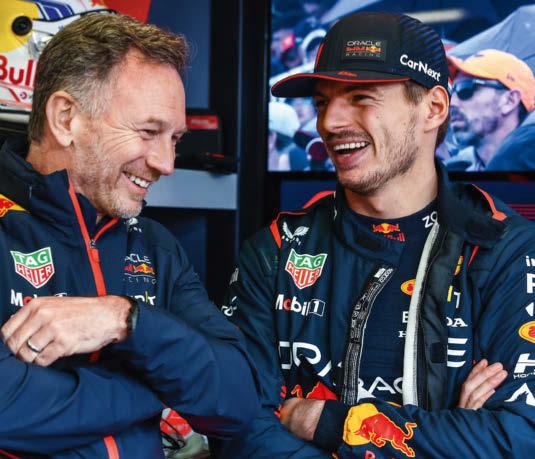


“Max has always been race-smart, right from the beginning“
FRANZ TOST
distinguish the important from the unimportant. He accepts the things he cannot change. In his younger years, he used to swear like a trooper.”

Travelling at speeds of up to 360kph, facing deceleration values of up to five times your own bodyweight and accelerating from 0 to 100kph in two-and-a-half seconds requires exceptional focus. Especially while simultaneously talking to the team on the radio about everything from monitoring tyre temperature to checking the charge status of the battery, all the while keeping a constant eye on the steering wheel to perfectly fine-tune the car for the approaching turn. So it follows Verstappen doesn’t lose his way outside the car, either: there’s no living it up, wild parties or salacious stories.
Verstappen is surrounded by a team as dedicated to success as he is. This includes principal

strategy engineer Hannah Schmitz, who makes decisions on pit stops, required lap times and perfect tyre maintenance. The British mother of two is a calm anchor who doesn’t secondguess herself. “She doesn’t know the word ‘maybe’,” says Dr Marko. The pay-off: strokes of genius such as Max winning in Hungary last year from 10th on the grid, on a track where overtaking is seen as virtually impossible.
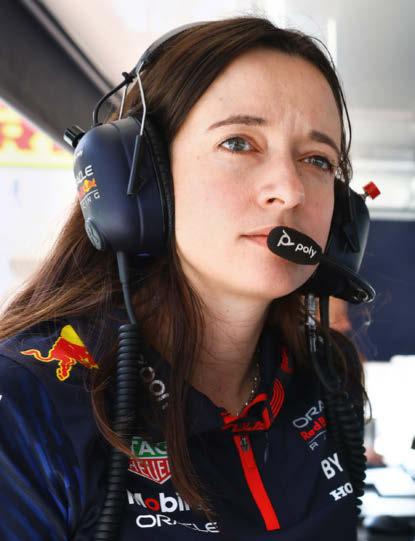
In June, Verstappen swapped racetrack for open sea to spend time with Arnaud Psarofaghis, skipper of Alinghi Red Bull Racing, the America’s Cup team hoping to win the 37th edition of the historic boat race in 2024. As the America’s Cup is known as the Formula 1 of sailing, the pair had plenty to share. “Both F1 and sailing are about communication and teamwork,” says Verstappen. “When I’m in the car, I communicate with so many people to make everything work over a race weekend, and it’s the same [in the America’s Cup boats] with the team of eight racers. It was great to hear the insights from the team, and about the technical side, for me to understand more about it.”
Dr Marko, head of Red Bull’s driver development programme which schooled champion F1 driver Sebastian Vettel as well as Verstappen, says Max always took responsibility for his actions. “I’ve heard almost every excuse in the book for why something isn’t working,” he recalls. “Max was different, even the first time he sat in my office in Graz at the age of 15. On his own. Without his father.” Dr Marko’s school has a reputation for being one of the toughest in the world, the next step for Verstappen after his father Jos’s own no-nonsense methods; he admits to being hard on Max,
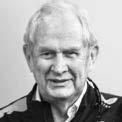
“I’ve heard almost every excuse in the book for why something isn’t working. Max was different”
DR HELMUT MARKO
something he believes was necessary in order for his son to reach the top of his sport.
What does Verstappen do when he’s not racing? He races. The Dutchman has been simulator racing at the highest level for more than a decade, alongside other seasoned racers including McLaren’s Lando Norris and, of course, players who have never sat in an actual F1 car. In 2020, Verstappen proved real-world talents translate into on-screen ability, beating 5,000 virtual racing drivers to win one of 20 coveted spots in the Porsche TAG Heuer Esports Supercup.


Verstappen’s career could have turned out very differently were it not for an F3 race at Germany’s Norisring in 2014 in the most difficult of conditions. Dr Marko was watching on TV and saw how Verstappen was one or two seconds faster per lap than the competition “and outclassed the entire field”. That was his ticket into F1. Verstappen finds difficult conditions no obstacle thanks to his training at karting tracks since childhood. “As soon as it starts to rain,” says Dr Marko, “everyone takes cover. Max [would] stay out and continue practising.”
It’s almost impossible to compare racers from seven decades fairly, but it can be agreed that Verstappen winning 68.18 per cent of his races in 2022 is staggering. And there is hardly an F1 stat where Verstappen – still just 25 – isn’t in the top 10 of all-time bests, if not already at the top. One of his records will exist for all eternity: the regulations have been changed since he first scored World Championship points aged just 17 years and 177 days – you now have to be at least 18 to join F1.
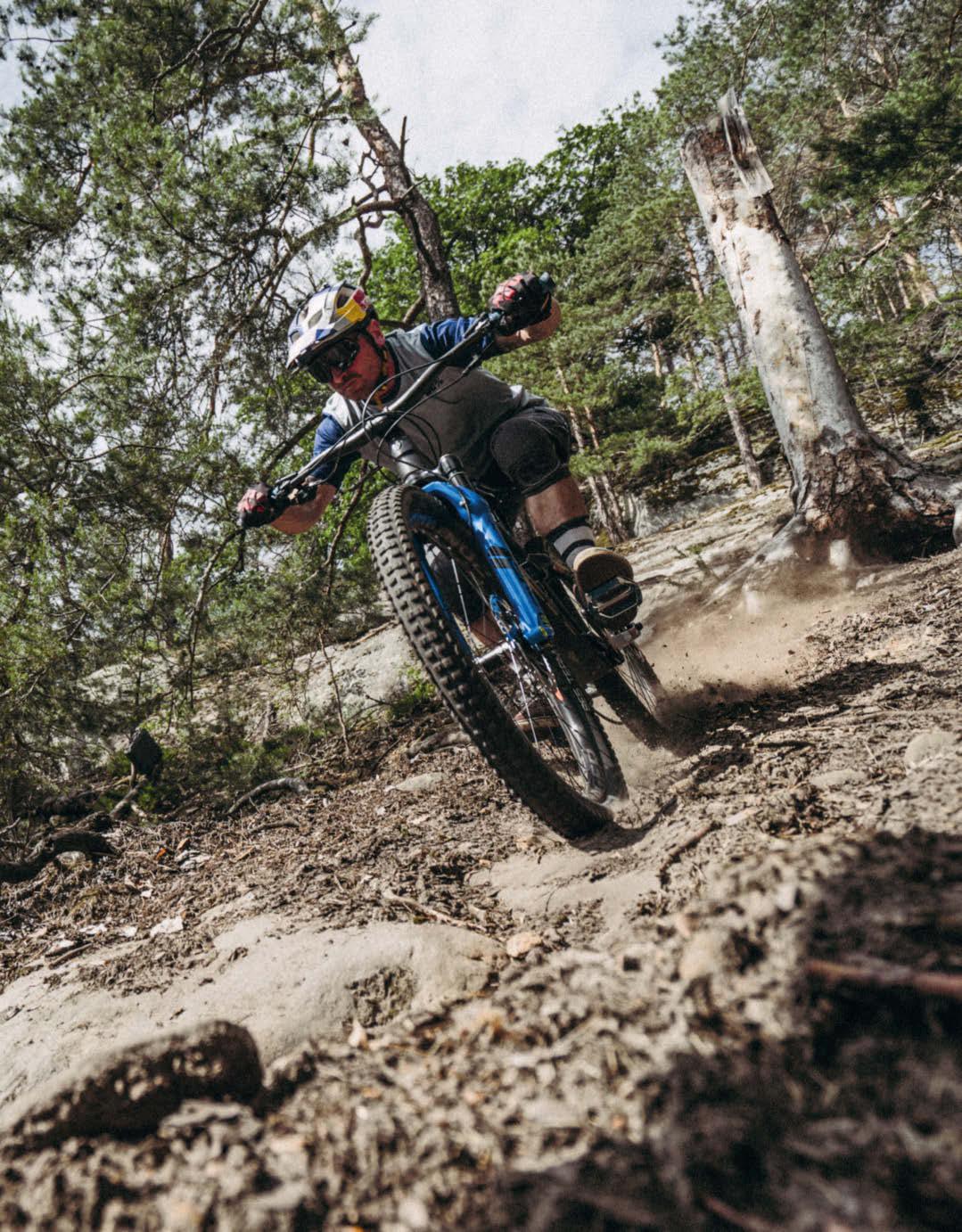


equip, and experience your best life
WATER
Cross-country swimming in the Lake District, UK

My feet slip on the Easter eggsized rocks as I stumble for stability. I stub my toes on an unforgiving stone, but the freezing temperature of Rydal Water has already numbed them in seconds; instead of a shooting pain, the only discomfort is a burning sensation on any bare skin not covered by my wetsuit. I want to leave this limbo and fully immerse myself, but the water remains too shallow. Grabbing the floating dry bag holding all my belongings, I continue the slow, clumsy path to greater depths. With ground temperatures hovering around 7°C, and the water not much warmer, the Lake District’s second smallest lake might seem an odd place for a dip in early April. But I’m here to try out cross-country swimming – a mix of backpacking and wild swimming. It was
dreamt up by two brothers from Yorkshire who wanted the rivers and lakes they encountered on an adventure to be an opportunity rather than an obstacle. The siblings created the RuckRaft –a packable, lightweight two-piece tow float and dry bag that enables you to travel from A to B, across land and water, without any restrictions.

My local guide, open-water swimming coach Lauren MunroBennett, points to a bank roughly 200m away. A keen runner and cyclist, in recent years I’ve
added swimming and triathlons to my CV, but while the distance would usually constitute a warm-up, the cold conditions are making even breathing a challenge. Plunging underwater, I start my front crawl, grateful for the added buoyancy of my RuckRaft, my feet now as responsive as two breeze blocks.
Five hours earlier, I had been warm and dry, waiting in the foyer of a hostel overlooking Windermere – although the weather had done its best to obscure the view of England’s largest lake. The vibrant skies of the previous evening’s sunset had been replaced by a low-lying fog and persistent drizzle, turning everything a glum grey. With an area of 2,362sq-km – just slightly smaller than all of Luxembourg – the Lake District is notorious for changeable conditions year-round. At least it would add some
“Plunging underwater, I start my front crawl, grateful for the added buoyancy, my feet now as responsive as two breeze blocks”
Charlie Allenby, adventure writerDirect trains run from London to Oxenholme, with transfers to Windermere. But a car provides the best access to the National Park’s lakes and fells
atmosphere to today’s proceedings: a 12km hike-swim loop that includes summitting Loughrigg Fell and paddling across Rydal Water before circling cross-country back to the start.

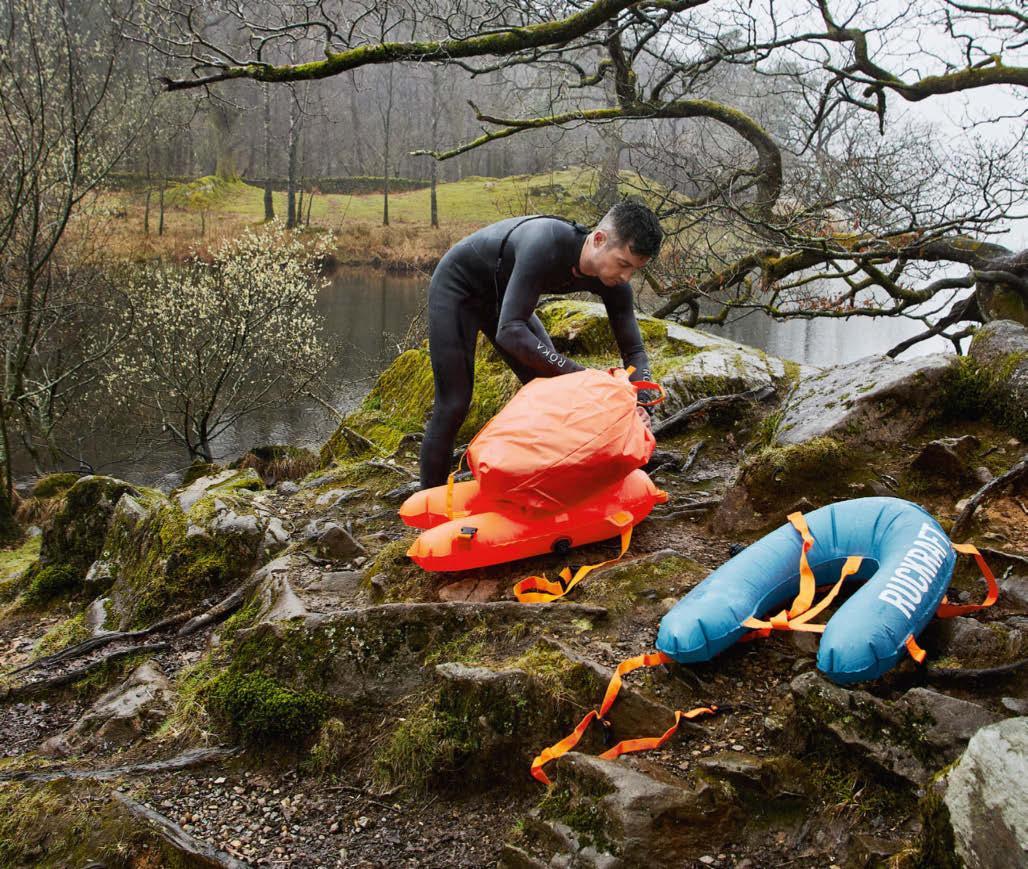
Met by Munro-Bennett, we drive to the trailhead, her makeshift camper van making short work of narrow lanes lined with dry stone walls. I’m handed a cross-country swimming kit, which I pack snugly in my day bag among extra layers and a wetsuit, and I’m pleasantly surprised by how light and compact it is.
Setting off along a bridle path, it’s not long before the trail starts to climb the foothills of Loughrigg Fell. Although a speed bump compared with the region’s tallest peak – the 978m Scafell Pike –the ascent isn’t without its difficulties: the boulder-strewn path becomes greasy in the mist, with a gradient more akin to
Changing tack: Allenby readies his RuckRaft for the open-water swimtraversing a near-vertical waterfall than a footpath. As we rise into the clouds, the track we’ve already covered disappears; soon it’s only possible to see within 10m.
With lactic acid burning my calves, we reach the rocky outcrop that marks its 335m summit, its trig point having been blown over by a storm last winter. Due to the conditions, there are no panoramic views to drink in as a reward, and given what happened to the last thing that hung around for too long on the exposed top, I’m keen to keep moving.
We bound down the northwestern side of the fell, and the trail drops away as dramatically as it rose. The surrounding haze makes it difficult to tell how far we’ve descended, and I have to do a double-take as Grasmere comes into view – my mind is convinced that its small lake is a continuation of the cloud. The adjacent village was once home to the Victorian poet William Wordsworth, who would spend many hours walking on the very paths I find myself on. Although I don’t spot any of the daffodils noted in his most famous work, it’s easy to see how the area’s natural beauty was a source of inspiration.
Our path hugs the River Rothay, which connects Grasmere to Rydal Water, and my mind races to what’s coming next. Changing into my wetsuit and concealing my hiking gear in the dry bag, I’m ready for my first A-to-B swimming experience. Despite the off-putting temperatures, after a few minutes of splashing around my cold limbs thaw out and I find my flow. Hikers stop and stare as the two of us make our way across the water – hi-vis blobs in hot pursuit. The rain even stops
Above Below’s two-piece tow: a cross-country swimming essential

The float’s U-shaped design was inspired by rib boats, keeping it stable and streamline with up to 15kg of load
The dry bag has a 120L capacity –more than enough for a weekend of multi-modal adventuring
The two-way valve allows you to inflate it by mouth in 30 seconds flat
The whole design weighs less than a kilo and packs down to the size of a sleeping bag
Marine-grade materials and tough welded seams make it equally at home in high seas and calm waters
momentarily. But the mist clings fast to the wooded slopes of Nab Scar, a fell on the lake’s northern bank.
I’m confident I can keep going, but, with an increasing risk of hypothermia, Munro-Bennett is keen for me to get out. Reaching our planned exit point, this is easier said than done. The base of my legs feel like stumps, and I trip my way across the shoreline’s light shingle before collapsing onto a log. As I fumble to get my dry clothes back on as quickly as possible, the circulation starts to return, the ground beneath my feet turning to hot coals.
Continuing with the hiking loop, the pain quickly subsides and I’m left with the warm endorphin high that year-round open-water swimmers talk about. Now sold on the concept of cross-country swimming, I start to plan more temperate, obstacle-free adventures.
Charlie Allenby is a London-based running, cycling and adventure writer; Instagram: @charlie.allenby. Above
Double-header:
Below, creators of the RuckRaft, will be hosting weekend events in Devon and the Lake District in July and September 2023; abovebelow.sc
 two swimming caps help keep out the worst of the chill
two swimming caps help keep out the worst of the chill
$4 MILLION IN LIFETIME DONATIONS

Heads. Quite important things really, you could go so far as saying essential even. At Endura, we certainly value them, which is why we not only apply all our own engineering prowess to them, but we also bring in key expert partners to help make our helmets some of the very best out there.


For 99.9% of the time, they just need to look great, be comfortable and provide great ventilation… and we think we have that well and truly covered, literally, as the new MT500 helmet offers more coverage, plenty of vents and unrivalled comfort. For the other 0.01% of the time, and it’s an astronomically important 0.01% of the time, the helmet needs to provide the best possible protection it can and here we offer up the triple whammy combination of Endura x Mips x Koroyd to really put our money where our mouth is in terms of rider safety.



endurasport.com





The Ribble Ultra SL R is an aerodynamically optimised weapon that helps you go faster with no extra effort
When cycling at 30kph, approximately 80 per cent of the power put through the pedals is spent overcoming air resistance – a figure that only increases the faster you go. Rather than accept this as a law of physics, British brand Ribble set about bending the rules to create the world’s fastest bike.
The Ultra SL R was optimised and tested extensively with someone in the saddle, to ensure it was fast when ridden and not just within the confines of a controlled, wind-tunnel environment.
Every tube used in the frame and fork has been shaped to remain fast in all conditions, from super-still, blue-sky days to the strong crosswinds common in the UK.

The one-piece handlebar and stem’s unique shape disrupts airflow to create a drag-reduction zone, minimising resistance and helping the rider slice through the atmosphere.
The Ultra SL R was not just designed with pros in mind – the benefits are even more significant for the average road cyclist, who can shave three minutes off a 100km ride compared with the same effort on Ribble’s Endurance SL R. ribblecycles.co.uk

Prototypes were
for wind-tunnel testing to confirm the designers had found a winning formula
With many recent gold medals in athletics, Hans Smeets might just be the fittest septuagenarian on the planet
Hans Smeets is an athletic marvel. At a time when his peers are adopting a slowerpaced approach to life, the 75-year-old from the Netherlands has struck out in front, winning 15 running world championships in the last 13 years. Smeets won his first gold medal as a 62-yearold in the 1,500m, while his most recent triumphs came at the 2022 World Masters Athletics Championships in Finland – a competition for ‘veteran’ athletes aged 35 and upwards – where he took gold in the 800m and 1,500m in the 75-plus category.
But he’s not only beating other septuagenarians on the athletics track. Last year, scientists at Maastricht University conducted tests on the Dutchman and he set new records in the laboratory, too: his VO2 Max score (a measurement of how much oxygen the body can utilise during intense exercise) was 50.5ml/kg/min – equivalent
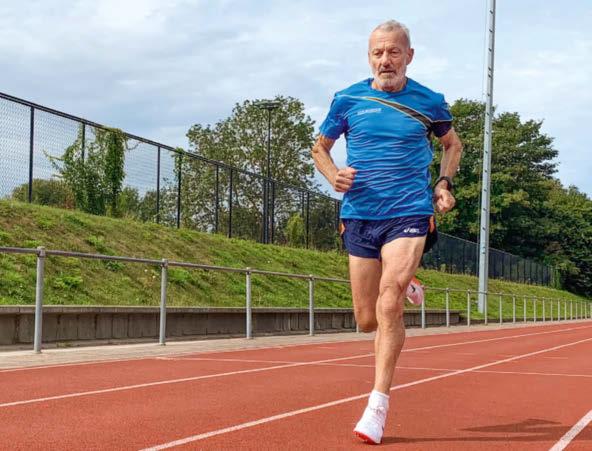
to that of an average man in his mid-twenties, making Smeets possibly the fittest 75-year-old of all time.
Smeets’s story is all the more astonishing given that he didn’t start running seriously until the age of 50 – proof that it’s never too late to lace up. He ran “without ambition” as a teen, but gave it up when he began working as an IT administrator. One day, after decades on the bench, Smeets joined some colleagues for a casual postwork run and realised he could easily beat them, so he decided to approach training seriously for the first time.
By the time he was 56, he was covering almost 160km a week, bagging a 5,000m PB of 17:11, and half-marathon and marathon times of 1:17:34 and 2:49:29 respectively.
If you’re struggling to keep up, Smeets’s advice should help you meet your performance targets, whatever your age.
“I always train on feeling,” Smeets says, explaining that fitness trackers and electronic metrics don’t work for him. Instead, he relies on intuition: if he feels good, he pushes himself; if not, it’s time for a slower, easier run. Next time you’re training, give this method a go – it might help you break through a plateau.
Despite never warming up or cooling down, Smeets claims he never suffers injuries or illnesses. He attributes his luck to having “a strong body”, as well as a devotion to cold showers. He might be on to something: a study in the Netherlands found that those who started their day with a
blast of cold water were 29-percent less likely to call into work sick. Adjusting his training to his years undoubtedly also keeps Smeets spry. “I’m still training at the same intensity as I did before,” he says. “Of course, it’s a lot slower now, and I have reduced my training days. Ten years ago, I would train every day – now it’s just four or five times a week.”
Smeets’s weekly training sessions may have adapted as he’s aged, but when racing season comes around he sticks to a tried-and-tested plan covering around 70km a week, with a longest run of just under two hours. While that might sound impossible to squeeze in if you’re not retired, he says the main thing is consistency. “It’s very important to me,’ Smeets says. “I have had the same training method for years, with a lot of hill training at a leisurely pace, and I also run a lot of competitions and adjust my training accordingly.” He attributes his fitness to the hills around his home in Gulpen, near the NetherlandsBelgium border, and explains that while now there are few he can only walk up, he tries to stick to a steady pace the rest of the time. “I train the calf and thigh muscles [crucial for middle distance] uphill,” he says. “I also land on the forefoot – this is the ideal style of training.”
Motivation can sometimes be hard to come by, but focusing on a win can often provide all the drive you need. It’s a tactic that works for Smeets: “I like running and, moreover, I’m very competitive and like to participate in races.” During each race, he’s focused entirely on his own run and the finish line rather than on the other competitors. “My motivations are the same as always,” Smeets laughs. “I want to win gold medals.”
“I’m still training at the same intensity as I did before”
Hans Smeets, veteran athlete
Muscle Stimulation controlled by smartphone-app coaching tracks your progress and helps you stay focused on your goal



British Superbike Championship riders Tim and Tom Neave on what it takes to beat your closest competition
At first look, a superbike might not seem much different from a mass-produced machine you could pick up in a shop, but beneath its fairing it’s a very different beast. Capable of reaching speeds of 320kph, these souped-up specimens can rival the performance of prototypes in MotoGP. Simply holding on through straights, hairpins and chicanes takes great strength and technique, but as British Superbike Championship riders Tim and Tom Neave, 28, prove, the best are born different.
It was by chance that the twins from Saxby, Lincolnshire, unearthed their talent for riding. Their grandad had bought them “one-and-a-half dirt bikes” – the half because it was always broken – but the brothers were destined to follow in the footsteps of their parents, who were farmers. That was until motorbike
racer Pete Boast moved into one of the village’s 13 houses.
Their dad suggested the rider might be able to repair their bike. Boast helped out, and when he’d got the machine running he noticed Tim had natural flair. At the time, the bike veteran was organiser of the British Short-Track Championship – a variation of flat-track racing, a discipline similar to speedway, albeit with brakes – so he invited the 14year-old to compete in a race.
Tim won and went on to become junior champion in his debut season, as Tom watched on. “Mum and Dad wanted us to do different sports,” says Tom. “They bought Tim a Honda CRF150 and me a shotgun to go claypigeon shooting.” But after a month Tom was itching to have a go. The next season, he got his chance, winning the junior ranks like his brother had.
Now, the Neaves are lining up together at the British Superbike Championship – the first time in its 35-year history that twins have battled it out on the track. “There’s always rivalry between siblings,” says Tom, “but I think as twins it’s a different level. Whether we’re battling for fourth or first, it doesn’t matter – we just want to beat each other.”
While Tom progressed to British Superbikes a season earlier than him, Tim believes that experiencing his brother’s trials and tribulations firsthand worked to his advantage when stepping up himself.

“I’ve been through it emotionally. I’ve seen what a tough year it was for Tom. I almost feel like I already had a year in superbikes.”
Each brother trains with a different coach to try to get the upper hand with fitness and nutrition. And both also focus on the mental side of racing. “On a race weekend, things build up and you can only handle so much – once your brain’s full, you start to make rash decisions,” says Tom. His coach has given him coping mechanisms to help him relax. “Each day, I lie down for 30 minutes, shut my eyes, and work from head to toe, creating tension in different parts of my body for five seconds before releasing. The release makes you feel heavy, you sink into it, and it clears your head.”
As identical twins, the pair have similar riding positions, but the application can make a difference. “Tom was always much faster to get to the front on the road-racing scene, but he crashed more often than me in the early days,” says Tim. “I adopted a more methodical approach – it always took me a little longer to find the speed and confidence, but when I found it and understood how I got there, it brought results.”
Losing to your closest rival is tough – “I hated being beaten by Tom, with a passion,” says Tim. But he now uses it as added motivation. “We’ve both reached a maturity where we can be happy for each other’s success, shake hands, and appreciate that the best man won. The rivalry is real, but it brings out the best in us and constantly pushes us forward.”
The Neaves have selected their favourite Belstaff pieces to mark the 75th anniversary of the Belstaff Trialmaster. Find out more at belstaff.com; britishsuperbike.com
“As twins, the rivalry is on a different level”
Tom Neave, superbike rider
Electric hybrid bikes get a bad rap. The bicycles themselves are perceived as bulky and brash, while their riders are viewed as ‘lazy’ and accused by purists of taking the easy option.


The new Canyon Roadlite:ON CF 9 LTD proves the reality couldn’t be further from the truth. Versatile, fun and fast, the German manufacturer’s latest release could revolutionise your riding experience – whether you’re just starting your cycling journey, or you’re a fitness-focused rider looking to maximise your time in the saddle.
The pinnacle of hybrid e-bikes, the Roadlite:ON CF 9 LTD features top-tier componentry in a sleek, minimalist package that will help you go further, whatever your goal. It’s centred around a lightweight carbon-fibre frame – the first time this material has been used in the brand’s asphaltfocused hybrid e-bike range. Finetuned to shave every gramme, while remaining robust and ready for the day-to-day grind, the result is a comfortable and capable ride that weighs just 14.45kg.
Almost a third of the Roadlite:ON CF 9 LTD’s weight comes from the FAZUA Ride 60 drive system, although its motor wouldn’t be obvious from a quick glance. Fully integrated into the bike’s frame, the unit combines 60Nm of torque with a 430Wh battery to provide four levels of support when
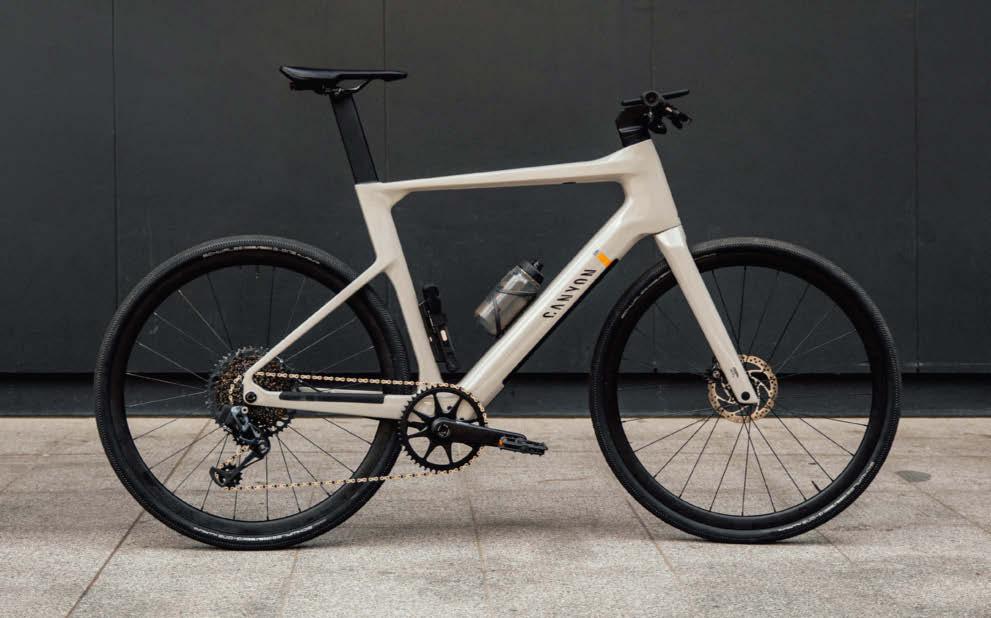
you need them, whether that’s pulling away from a traffic light or taking the sting out of an ascent. Changing gears is taken care of by the SRAM Eagle AXS wireless electronic 12-speed gearing, leaving you with buckets of range even when riding unassisted.
Its innovative design extends to functional flourishes: ergonomic handlebars and grips minimise fatigue on longer rides; cables are internally routed to guard against rain and road spray; integrated front and rear lights help you stay safe and seen after dark.
Individually, these are all features that would help an e-bike stand out. But as one pioneering package, the Canyon Roadlite:ON CF 9 LTD leaves the competition for dust. Find out more at canyon.live/roadliteONCF

In a world of downloadable content and esports, it can be refreshing to return to the roots of gaming, a time when personal consoles were still in their infancy and, instead of playing online, you’d wait in line for your turn on the arcade machine. The undisputed king of this era was Pac-Man unveiled to the world in 1980. Millions were quickly hooked on guiding the titular character – best described as a peeled Mini Babybel with a slice missing – around the game’s maze, gobbling up Pac-Dots while swerving multi-coloured ghosts Blinky, Pinky, Inky and Clyde (or dispatching them with a Power Pellet). Four decades on, Pac-Man is regarded one of the all-time greats, but finding an original arcade version is as tough as reaching the game’s 256th level. LEGO understands this, which is why it has created the next best thing for die-hard fans. Part of its LEGO Icons series, the Pac-Man Arcade is a 2,651-brick recreation, complete with moving joystick, illuminated coin slot, and a winding mechanism that simulates the thrill of the chase in the mechanical maze. Plus, the cabinet measures only 32cm tall, so you won’t have to reorganise your living room to accommodate it. lego.com
Recreate a retro classic with LEGO’s Pac-Man Arcade


Along time ago in a galaxy far, far away… well, you probably know the rest. Back down here on Earth, it’s hard to overstate the influence of the Star Wars franchise. And when it comes to gaming, filmmaker George Lucas’s world of Sith Lords and Stormtroopers has provided endless creative inspiration, spawning more than 100 video games over the years – from simple 8-bit arcade offerings to later releases as slick and cinematic as the movies themselves.
Star Wars Jedi: Survivor falls squarely in the latter camp. In the third-person, action-adventure game, the player controls Jedi Knight Cal Kestis as he and his friends battle to survive tyrannical oppression from the Galactic Empire. As its title suggests, a crucial part of the game is fighting – and winning – against opponents of all shapes and sizes, and as this is Star Wars there’s an obvious weapon of choice: the lightsaber.

One person who knows more than most about this style of combat is Kenny De Bellio. A Star Wars obsessive right from the moment when, aged three, he first saw Episode IV – A New Hope, De Bellio was in his backyard “waving a sword around and pretending I was a Jedi” for months after. At the age of five, he began studying martial arts, which sparked a lifelong interest and a career teaching others.
In 2017, De Bellio decided to combine his two major passions, founding First Strike Lightsaber Combat Simulations, a club in Rochester, Kent, that teaches a mix of martial arts and the sword-fighting techniques favoured by Jedis. But how does real-life lightsaber combat compare to watching it on-screen or playing a video game? And what tricks do you need to succeed? Here’s a (Jedi) masterclass…
Real-life lightsaber savant Kenny De Bellio shares how to perfect your cross-sword combat
There are seven forms of lightsaber combat, each one progressively more difficult. The starting point is ShiiCho, which involves holding your lightsaber in two hands.
“It’s defensive, and it’s about restraint, control and discipline,” explains De Bellio. “Shii-Cho is what Obi-Wan Kenobi might have used when defending himself against the Dark Side.” Anyone can use any of the forms, but some do lend themselves more to the Dark Side – for example, form five, or Djem So, is the style that Darth Vader uses in Rogue One and A New Hope. “He’s relying on strength and aggression, which is what the Dark Side is all about. There’s no finesse; it’s just brutal.”

“Mastering footwork and body movement is fundamental,” says De Bellio. “If your footwork is off, you won’t get the techniques right.” When teaching blocks, he gets students to start without a lightsaber. “Sometimes you put a lightsaber in someone’s hands and then their body movement goes flying out the
window. You should be able to sidestep or pivot out of the range of your opponent. I encourage people to move with their hips rather than their feet – wherever the hips turn, the feet will follow.”
You might think that a double-bladed lightsaber (also known as a saberstaff) like the one used by Darth Maul in Episode I – The Phantom Menace would give you double the power, but that’s not necessarily the case. “When it comes to real combat, you’ve only got one end of the saber in contact with the opponent at any one point,” says De Bellio. “If you fight with two sabers, you’ve got twice as much potential to beat your opponents.” Two isn’t always better than one, though. The downside of doubling up is that one of your hands will undoubtedly be weaker than the other, which an opponent can use to their advantage: “Everyone’s got a weak side, and you’ll be able to spot it – they’ll put their strongest foot forward.” If you’re fighting an opponent with two lightsabers, work towards their weak side: “It’ll be less effective, so you force them to attack with that hand.” This also increases the chances of disarming them, levelling the playing field.
When De Bellio runs team combat sessions, people inevitably end up outnumbered. “It’s not uncommon for it to end up as one versus four,” he explains. “Sometimes the lone player does win – the odds are stacked against you, but it’s doable. Keep moving and try to pick off the others one at a time, targeting the weakest links first. If you just go static, you won’t win: you’ll have four opponents poking you with lightsabers in a matter of seconds.”
“There’s no finesse with the Dark Side; it’s just brutal”
Kenny De Bellio, lightsaber master

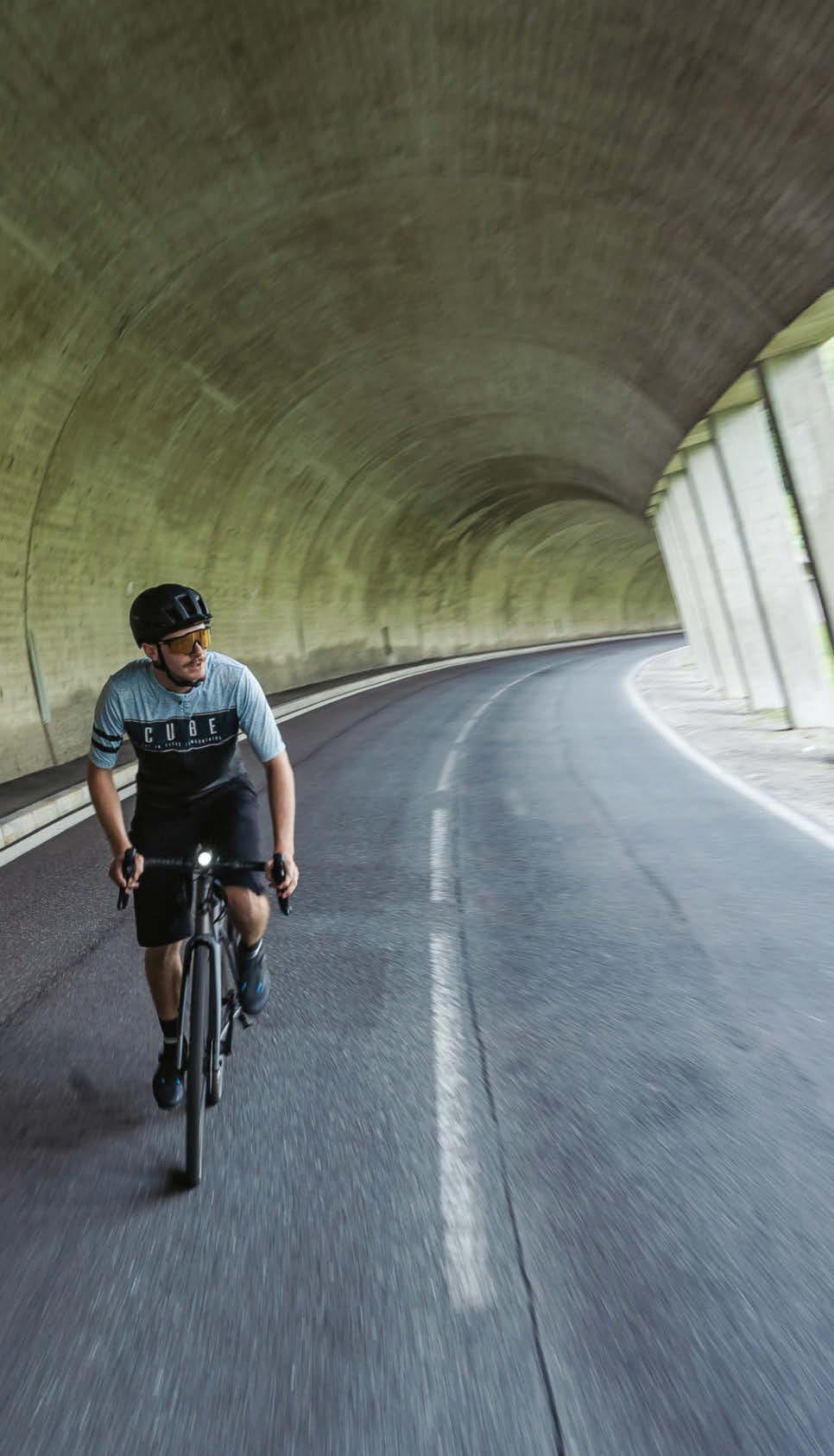
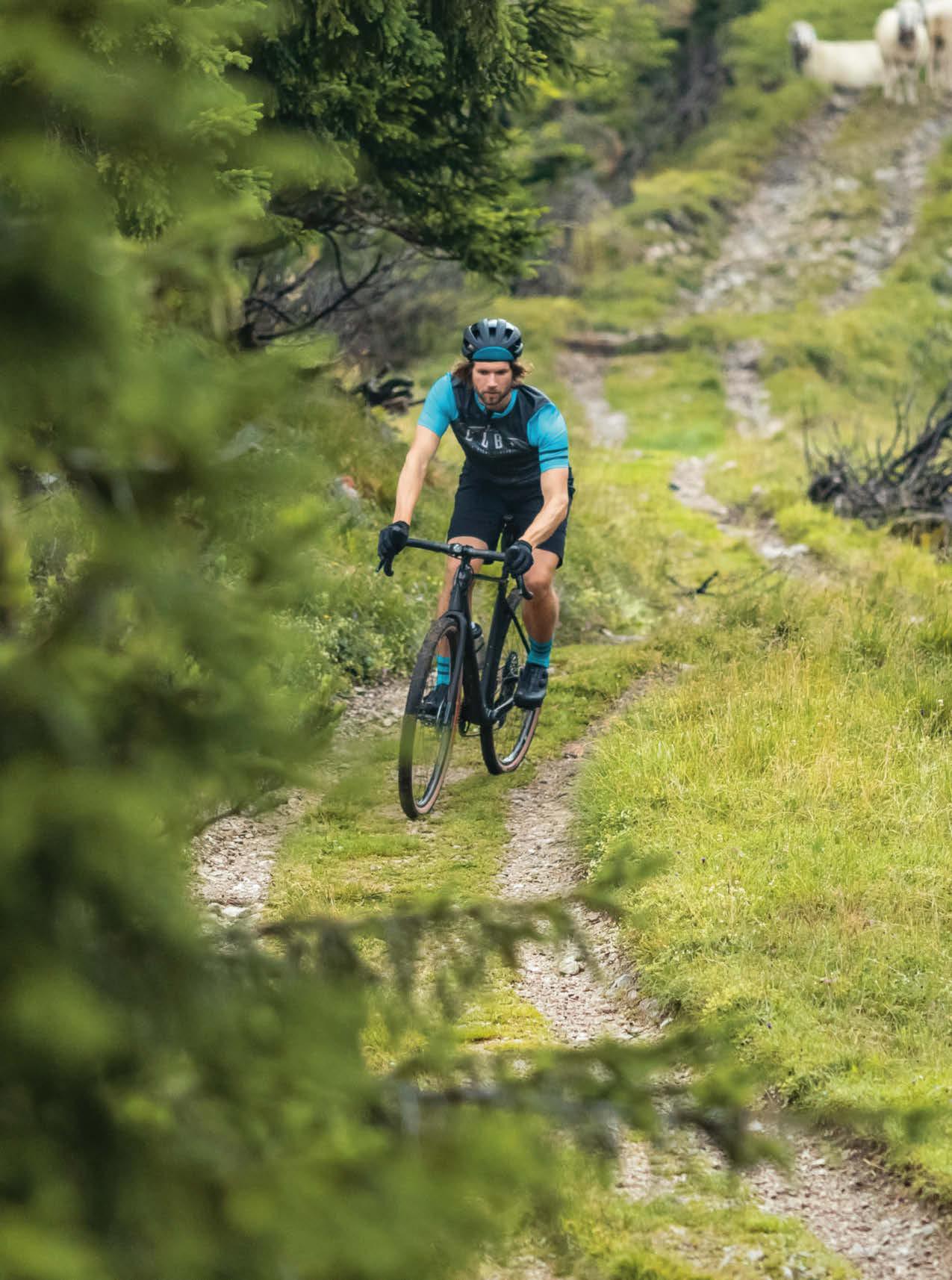


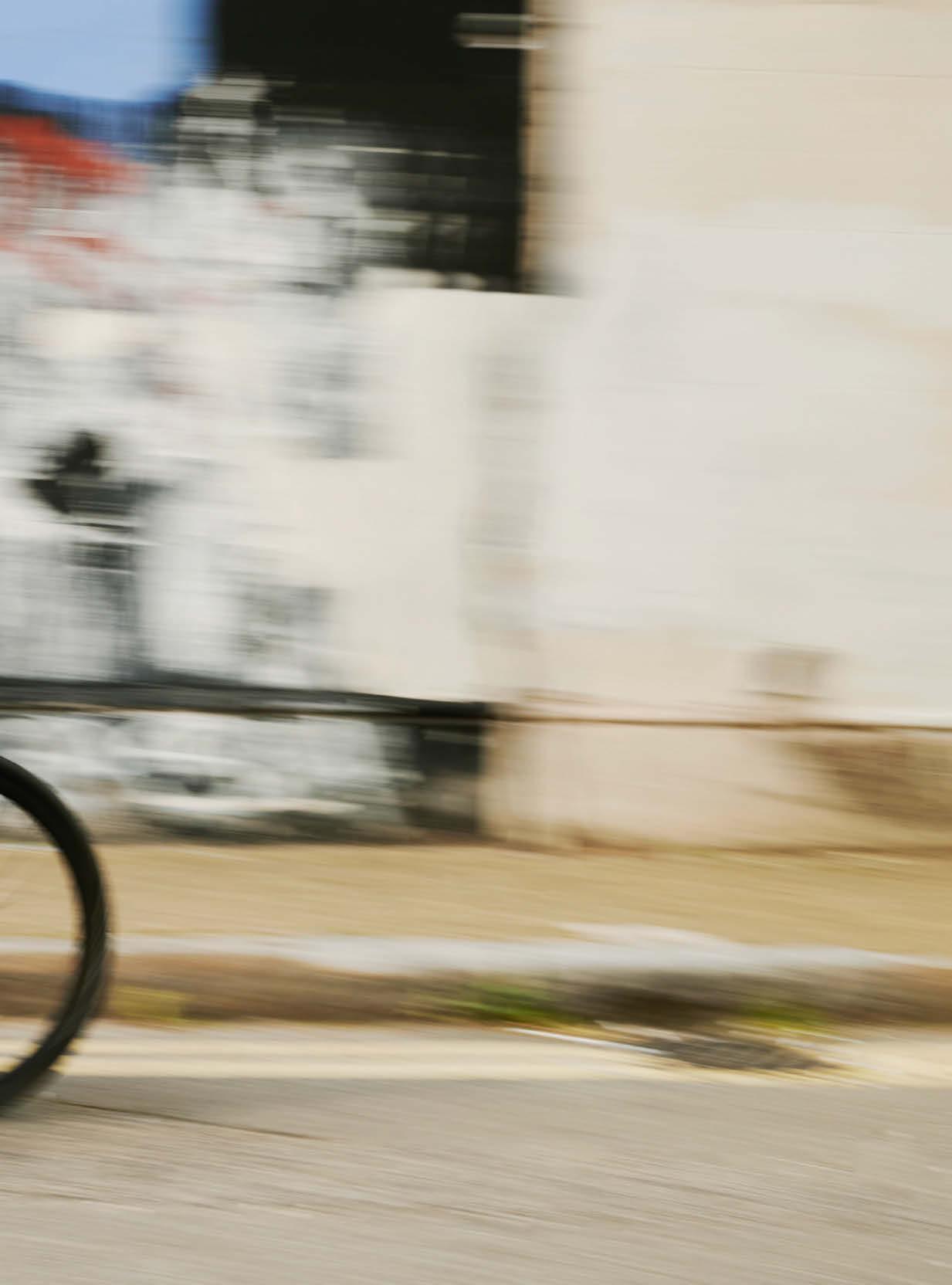
FJÄLLRÄVEN S/F Prevail Helmet and S/F Cotton Pocket T-shirt, fjallraven. com; OAKLEY BXTR Metal Sunglasses, oakley.com; CHROME INDUSTRIES
Buran III Messenger Bag, chromeindustries.com; COTOPAXI Valle Active Shorts, uk.cotopaxi.com; HAMILTON Khaki Navy Frogman Auto Watch, hamiltonwatch.com; STANCE Cabana Crew Socks, stance.eu.com; K-SWISS SI-18 Rannell SDE Shoes, kswiss.co.uk; MARIN Sausalito E1 E-bike, marinbikes.com
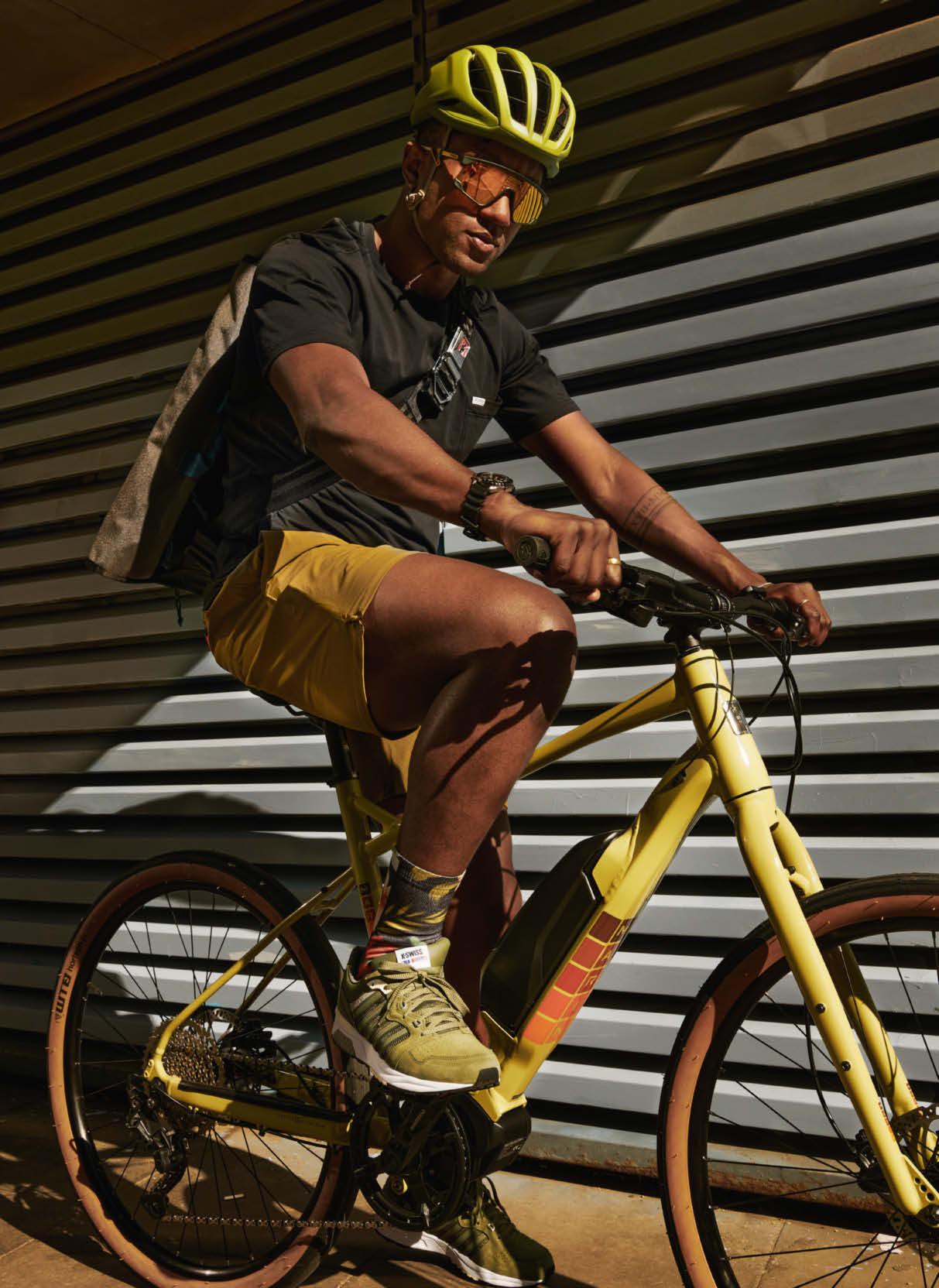
NUTCASE HELMETS
Vio Commute LED Helmet, nutcasehelmets.com; MESSYWEEKEND

Liv Sunglasses, messyweekend.com; ORTLIEB Velocity Backpack, ortlieb.com; STANCE Live Your Values T-shirt, stance.eu.com; PICTURE ORGANICS
Oslon Printed Tech Shorts, picture-organicclothing.com; SWATCH C-Grey Bioceramic Watch, swatch.com; TEVA Hurricane XLT2 Sandals, teva-eu.com; CANNONDALE Mavaro Neo 3 E-bike, cannondale.com

GIRO Ethos MIPS Helmet, giro.com; MESSYWEEKEND New Depp Sunglasses, messyweekend.com; OSPREY Daylite Tote Pack, ospreyeurope.com; BELSTAFF Hale Sweatshirt and Signature Sweatshorts, belstaff.com; NIXON Siren Watch, uk.nixon.com; STANCE Round About Crew Socks, stance.eu.com; ON RUNNING Cloudeasy Shoes, on-running.com; BENNO BIKES RemiDemi E-bike, bennobikes.com


NUTCASE HELMETS Vio Commute LED Helmet, nutcasehelmets.com; HINDSIGHT Artemis Cycling Glasses, hindsight.store; DB

JOURNEY Freya Backpack 22L, uk.dbjourney.com; NORTH SAILS T-shirt with Chest Pocket, webstoregb.northsails.com; 686 Everywhere Hybrid Shorts, eu.686.com;
ENDURA Hummvee Plus Gloves II, endurasport. com; TISSOT T-Race Chronograph Watch, tissotwatches.com;
STANCE Triptides Quarter Socks, stance.eu.com; NEW BALANCE BB550 Shoes, newbalance.co.uk; MONDRAKER Chaser RX E-bike, mondraker.com
HJC Calido Urban Helmet, hjcsports.com; HINDSIGHT Morpheus
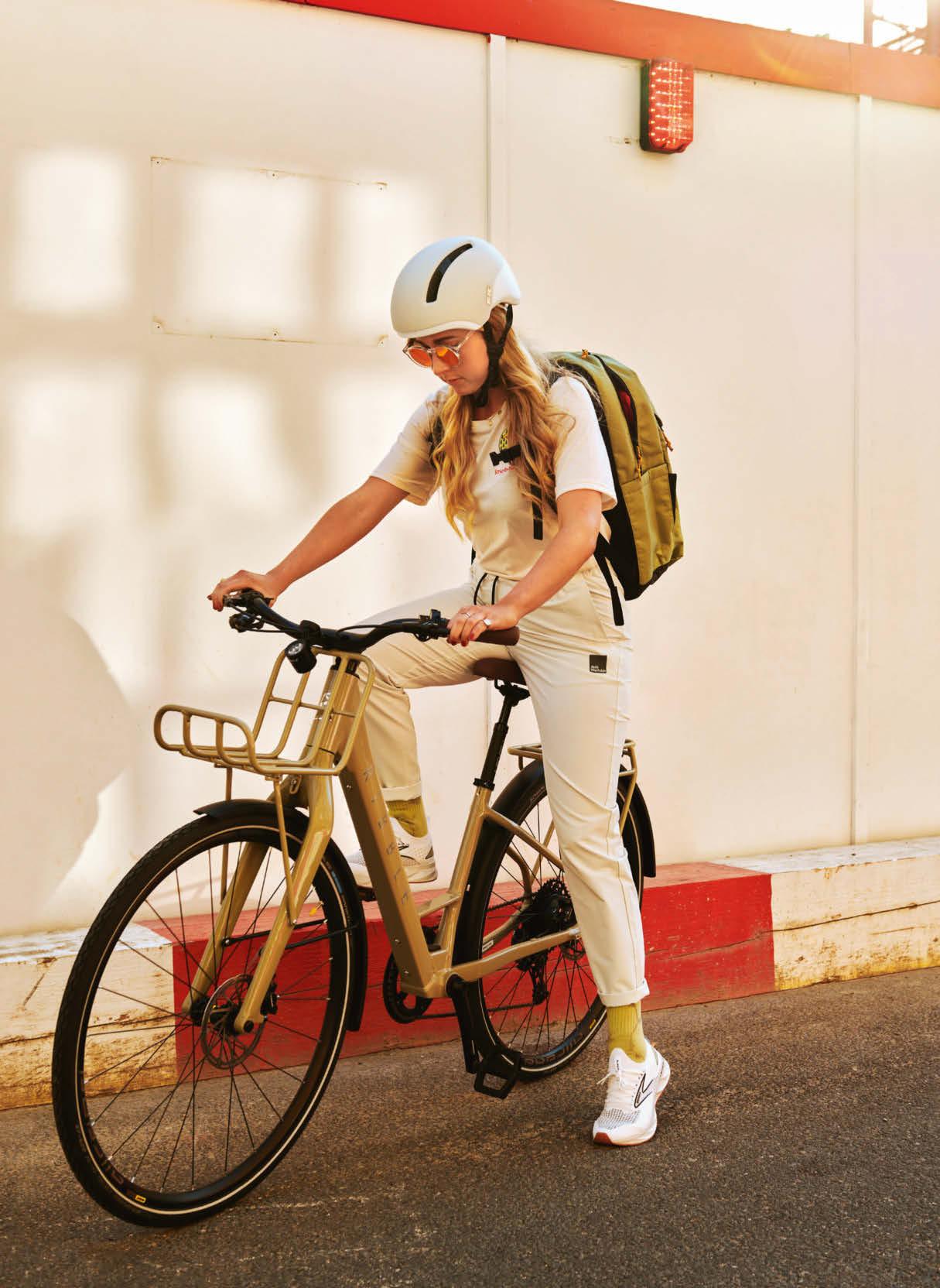
Cycling Glasses, hindsight.store; CHROME INDUSTRIES
Ruckas 23L Backpack, chromeindustries.com;
SMARTWOOL Explore The Unknown Graphic Tee, smartwool.co.uk; JACK WOLFSKIN Bike Commute Pants, jack-wolfskin.co.uk; STANCE Lint Crew Socks, stance.eu.com; BROOKS Levitate StealthFit 6 Shoes, brooksrunning.com; RIBBLE Urban AL e E-bike, ribblecycles.co.uk






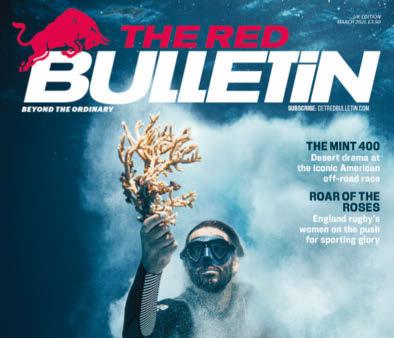
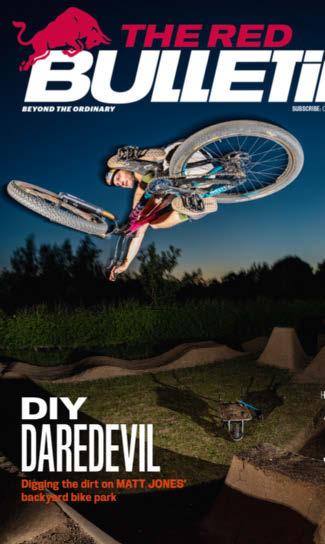
The next issue is out on Tuesday 12 September with London Evening Standard. Also available across the UK at airports, universities, and selected supermarkets and retail stores. Read more at theredbulletin.com
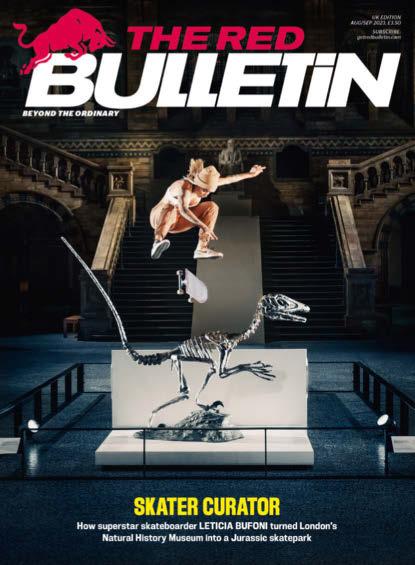
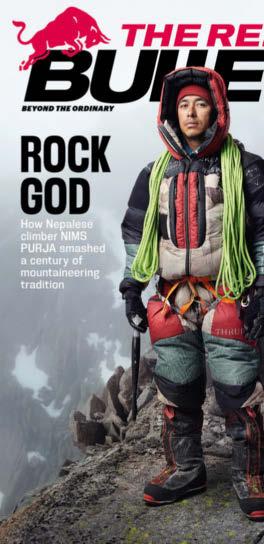

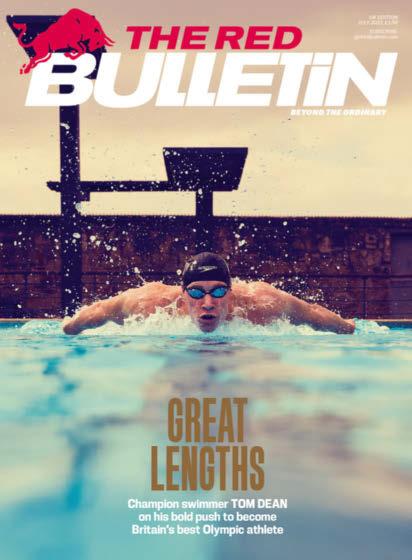


Perched high above the district’s other buildings, with a 360° view of the city skyline, this tropical-themed rooftop bar is among the best places in south London to enjoy a drink as the sun goes down. First-time visitors are advised to try the infamous ‘Roof Juice’, a fruity G&T with limoncello, blackberry liqueur, elderflower and passionfruit syrups, and lemon juice.
Be sure to pair the cocktail with a freshly made pizza from on-site food pop-up Share A Slice.
Come for: amazing sunsets; a topnotch Aperol Spritz; open-air film nights; tropical vibes; good times. Bussey Building, Bussey Alley, off 133 Rye Lane, SE15; busseyrooftopbar.com

Does the idea of reclining on a chaise longue while sipping a martini appeal?
If so, this shabby-chic cocktail bar is for you. It may look unassuming from the road, but head inside to discover beautiful hidden décor. Come for: talented mixologists; the chilled ambience; friendly people. 138 Rye Lane, SE15; Instagram: @zapoipeckham
Opened in 2017 by Peckham-raised Clement Ogbonnaya, this is a true locals’ pub and community venue. A space where the area’s residents, – old and new – co-exist and thrive. Come for: the on-tap selection; food by White Men Can’t Jerk; community. 1 Clayton Road, SE15; princeofpeckham.co.uk
Venues with good drinks, a nice crowd, exciting events and late opening times are hard to find in London, but Tola has the lot. At this intimate spot, the best local DJs serve up a proper sweaty party. Come for: great music; food by Yard Sale Pizza; the roof terrace. 56 Peckham High Street, SE15; tolapeckham.com
Ranked ahead of New York’s West Village in the world’s coolest neighbourhoods, this area of south London is no longer a locals’ secret. Here’s our pick of Peckham’s finest drinking holes...




Owned by musicians Nathanael Williams and Bradley Zero, this bar and restaurant celebrates the food, drink and sounds of the African-Caribbean diaspora. Come for: crate digging; a great sound system; coconut mackerel run-dung dumplings. Unit 4.1, 133 Copeland Road, SE15; jumbipeckham.com
From Street Fighter to Pac-Man, this ’80s-themed venue houses as big a selection of retro video-game cabinets in its gaming space as it does beers behind the bar. Grab a drink and a handful of coins from the staff and play into the early hours. Come for: retro fun; the basement parties; happy hour.
187 Rye Lane, SE15; fourquarters.bar


Who is this generation’s artist? That visionary elusive enough to inspire tomorrow’s musicians, who you’ll wish you’d seen live so you could regale your grandchildren with the legendary tale? This year’s line-up of east London’s beloved electronic music festival includes two strong contenders. One is Aphex Twin – the Cornish electronica legend hailed as a modern-day Nikola Tesla by his devotees – who will perform one of his rare live outings. The other – Swedish cult musician Fever Ray, whose icy electronic albums have blurred the lines between pop and avant-garde to critical acclaim – is set to return to the UK for the first time in six years. Victoria Park, London; fielddayfestivals.com

Bicycles are like dogs: same species but totally different shapes, sizes and, in the case of bikes, sporting disciplines, of which the UCI (Union Cycliste Internationale) sets the rules and organises annual competitions around the world. But for the first time (and, going forward, every four years ahead of the Olympics), multiple strains of UCI World Championship – from road and track to MTB and BMX – are coming together for the biggest cycling event ever. A chance for Brits Tom Pidcock and Evie Richards (pictured) to flex their multidisciplinarian calves. Across Scotland; cyclingworldchamps.com
Freediving is all about depth – not just of water, but of physical and mental fortitude. It’s something Italian diver Alessia Zecchini had to draw on in 2019 when attempting the world depth record. This film follows her journey from childhood to meeting dive mentor Stephen Keenan, who worked to help her attain that goal. Premiered at this year’s Sundance, and likened to Free Solo for freediving, its tense underwater scenes will have audiences holding their breath, too. Best viewed on a big screen, it’s showing theatrically at just one cinema for one week, before moving to Netflix on July 19. Curzon Camden, London; curzon.com

Being hailed as the UK’s third most Instagrammable festival – the first two are Glastonbury and Creamfields – is almost an insult to this unique five-day celebration. Alongside the usual music stages (headlining are Lorde, Liam Gallagher and Florence + The Machine) is the fact that the party takes place across Watergate Bay and Fistral Beach – the home of British surfing. For those who are a tad green in the blue, there are surf, kayak and paddleboard lessons. There’s also a strong sustainability theme, from reusable cups to beach cleans, with money raised going to Surfers Against Sewage. Watergate Bay, Cornwall; boardmasters.com


In summer 2021, collectives from the UK’s LGBTQIA+ dance-music scene, headed by Clayton Wright of Little Gay Brother and DJ Saoirse Ryan, came together to launch the UK’s first queer and trans electronic music festival, taking over industrial spaces across east London’s Hackney Wick for a day and night of celebration and safe-space clubbing. Since then, Body Movements has become a staple of the capital’s queer calendar, and, following a storming Winter Edition at Printworks London (RIP), returns to Hackney for a bigger, better, third summer session, bringing together 29 UK collectives and more than 100 acts across 16 venues. Hackney Wick, London; bodymovements.co.uk
This audiovisual exhibition reflects on the urgent needs of the climate emergency, but behind it is a story of positivity. Reframe is a multi-city programme offering 80 young Black creatives tutoring, tools and resources to develop their artistic careers. The result is proof that by working together, great things can be achieved. Southbank Centre, London; southbankcentre.co.uk

Editor Andreas Kornhofer
Editor-in-Chief
Andreas Rottenschlager
Editor-in-Chief DACH
David Mayer
Creative Directors
Erik Turek (manager), Kasimir Reimann
Copy Chief
David Pesendorfer
Art Directors
Marion Bernert-Thomann, Miles English, Tara Thompson
Designers
Martina de Carvalho - Hutter, Kevin Faustmann-Goll, Carita Najewitz
Photo Editors
Eva Kerschbaum (manager), Marion Batty (deputy), Susie Forman, Tahira Mirza, Rudi Übelhör
Global Content
Tom Guise (manager), Lou Boyd
Head of Audio
Florian Obkircher
Managing Editors
Ulrich Corazza, Marion Lukas -Wildmann
Publishing Management
Sara Car-Varming (manager), Ivona Glibusic, Melissa Stutz (Innovator)
The Red Bulletin is published in six countries. This is the cover of our US issue for August/ September, featuring National Women’s Soccer League star Trinity Rodman.

For more stories beyond the ordinary, go to: redbulletin.com
Editorial Director A lexander Müller-Macheck
Head of Media Sales & Partnerships
Lukas Scharmbacher
Head of Co -Publishing Susanne Degn - Pfleger
Project Management Co-Publishing, B2B Marketing & Communication
Katrin Sigl (manager), Katrin Dollenz, Michaela Kroboth, Teresa Kronreif (manager Corporate Marketing & Communications), Julia Leeb, Valentina Pierer, Stefan Portenkirchner (Corporate Communications), Bernhard Schmied, Jennifer Silberschneider, Sophia Wahl (Corporate Marketing)
Creative Services Verena Schörkhuber-Zöhrer (manager), Sara Wonka, Tanja Zimmermann, Julia Bianca Zmek, Edith Zöchling-Marchart
Commercial Management Co-Publishing

Alexandra Ita
Editorial Co - Publishing Gundi Bitter mann, Michael Hufnagl, Alexander Klein, Irene Olorode, Mariella Reithoffer, Wolfgang Wieser
Executive Creative Director Markus Kietreiber
Senior Manager Creative Elisabeth Kopanz
Art Direction Commercial & Co-Publishing
Peter Knehtl (manager), Silivia Druml-Shams, Erwin Edtmayer, Simone Fischer, Andreea Gschwandtner, Lisa Jeschko, Araksya Manukjan, Carina Schaittenberger, Julia Schinzel, Florian Solly, Sophie Weidinger
Direct to Consumer Business Peter Schiffer (manager), Marija Althajm, Victoria Schwärzler, Yoldaş Yarar
Retail & Special Projects Manager Klaus Pleninger
Advertising Manuela Brandstätter, Monika Spitaler
Production Veronika Felder (manager), Martin Brandhofer, Walter O. Sádaba, Sabine Wessig
Repro Clemens Ragotzky (manager), Claudia Heis, Nenad Isailović, Sandra Maiko Krutz, Josef Mühlbacher
Finance Mariia Gerutska (manager), Elisabeth Maier
MIT Martin Bartmann, Christoph Kocsisek, Michael Thaler
IT Service Desk Maximilian Auerbach
Operations Alice Gafitanu, Melanie Grasserbauer, Alexander Peham, Thomas Platzer, Raphaela Pucher
Project Management Dominik Debriacher
Assistant to General Management Sandra Artacker
CEOs Red Bull Media House Publishing
Andreas Kornhofer, Stefan Ebner
Editorial office Am Grünen Prater 3, A-1020 Vienna Phone +43 1 90221 - 0 Web redbulletin.com
Published by Red Bull Media House GmbH, Oberst-Lepperdinger-Straße 11–15, A-5071 Wals bei Salzburg, FN 297115i, Landesgericht Salzburg, ATU63611700
Executive Directors
Dietmar Otti, Christopher Reindl, Marcus Weber
THE RED BULLETIN
United Kingdom, ISSN 2308-5894
Editor
Ruth McLeod
Chief Sub-Editor
Davydd Chong
Country Project Management
Ollie Stretton
Advertising Sales
Mark Bishop, mark.bishop@redbull.com
Printed by Quad/Graphics Europe Sp. z o.o., Pułtuska 120, 07-200 Wyszków, Poland
UK Office
Seven Dials Warehouse, 42-56 Earlham Street, London WC2H 9LA Tel: +44 (0) 20 3117 2000
Subscribe getredbulletin.com
Enquiries or orders to: subs@uk.redbulletin.com. Back issues available to purchase at: getredbulletin.com
Basic subscription rate is £20.00 per year. International rates are available. The Red Bulletin is published 10 times a year. Please allow a maximum of four weeks for delivery of the first issue
Customer Service
+44 (0)1227 277248, subs@uk.redbulletin.com
THE RED BULLETIN
Austria, ISSN 1995-8838
Editors
Nina Kaltenböck (manager), Lisa Hechenberger
Proofreaders
Hans Fleißner (manager), Petra Hannert, Monika Hasleder, Billy Kirnbauer-Walek Country Project Management
Julian Vater
Media Sales & Partnerships
Thomas Hutterer (manager), Michael Baidinger, Franz Fellner, Ines Gruber, Moritz Philipp Haaf, Wolfgang Kröll, Gabriele MatijevicBeisteiner, Yvonne Mensik, Alfred Minassian, Nicole Okasek-Lang, Britta Pucher, Nicole Umsait, Johannes Wahrmann-Schär, Ellen Wittmann-Sochor, Ute Wolker, Christian Wörndle, Sabine Zölß
THE RED BULLETIN
France, ISSN 2225-4722
Editors
Pierre-Henri Camy (manager), Marie-Maxime Dricot, Christine Vitel
Country Project Management
Marin Heitzler
Media Sales & Partnerships
Yoann Aubry, yoann.aubry@redbull.com
THE RED BULLETIN
Germany, ISSN 2079-4258
Editor
David Mayer
Proofreaders
Hans Fleißner (manager), Petra Hannert, Monika Hasleder, Billy Kirnbauer-Walek
Country Project Management
Natascha Djodat
Media Sales & Partnerships
Thomas Hutterer (manager), Michael Baidinger, Franz Fellner, Ines Gruber, Moritz Philipp Haaf, Wolfgang Kröll, Gabriele MatijevicBeisteiner, Yvonne Mensik, Alfred Minassian, Nicole Okasek-Lang, Britta Pucher, Nicole Umsait, Johannes Wahrmann-Schär, Ellen Wittmann-Sochor, Ute Wolker, Christian Wörndle, Sabine Zölß
THE RED BULLETIN
Switzerland, ISSN 2308-5886
Editor
Saskia Jungnikl-Gossy
Proofreaders
Hans Fleißner (manager), Petra Hannert, Monika Hasleder, Billy Kirnbauer-Walek
Country Project Management
Meike Koch
Media Sales & Brand Partnerships
Christian Bürgi (team leader), christian.buergi@redbull.com
Marcel Bannwart, marcel.bannwart@redbull.com
Jessica Pünchera, jessica.puenchera@redbull.com
Michael Wipraechtiger, michael.wipraechtiger@redbull.com
Goldbach Publishing
Marco Nicoli, marco.nicoli@goldbach.com
THE RED BULLETIN
USA, ISSN 2308-586X
Editors
Peter Flax (manager), Melissa Gordon, Nora O’Donnell
Copy Chief
David Caplan
Country Project Management
Branden Peters
Advertising Sales
Marissa Bobkowski, marissa.bobkowski@redbull.com
Tanya Foster, tanya.foster@redbull.com
Todd Peters, todd.peters@redbull.com
Dave Szych, dave.szych@redbull.com
If you’re asked to imagine a backpack, there’s a good chance that Fjällräven’s Kånken will spring to mind. Originally launched by the Swedish brand in 1978 as a durable and comfortable way for kids to carry their stuff to school, the backpack’s popularity has soared in the decades since – there won’t be a tube carriage, airplane or office that doesn’t contain a bag adorned with the company’s Arctic fox logo.
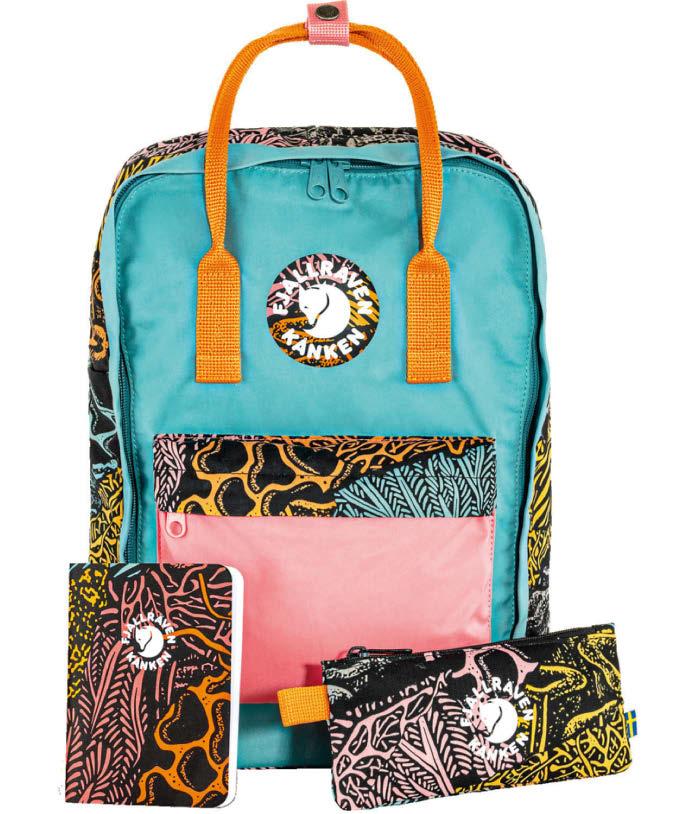
But when you want to reinvent a classic, who do you turn to? Enter Martin ‘Mander’ Ander – the Stockholm-based artist and graphic designer responsible for more than 300 skateboard deck illustrations, and concert poster artwork for music acts including Tyler, The Creator and The Strokes.
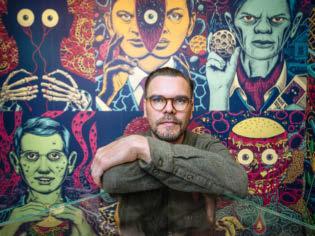
“For me, Kånken is a staple in Swedish fashion,” Mander says. “Even though I’ve worked with some of my favourite skate brands and produced hundreds of skate graphics over the years, Kånken felt really special because it’s such an iconic product.”
Mander was tasked with bringing his signature ’80s punk-fanzine style to proceedings as part of Fjällräven’s Kånken Art series – a project that sees different artists use the backpack as their canvas to create a limited-edition design that reflects their personal relationship with nature.
Although “generally more of a street guy”, Mander uses the great outdoors as a way to take a break from his work, which “involves staring at a screen or a piece of paper for long periods of time”. He adds, “I also think much more clearly when I’m out walking or on my bike – I often get even more ideas while I’m out there.”
In fact, the woods close to his home are where the foundation of his design comes from. “I started looking for the structures and patterns in nature and
began to draw them in my style,” says Mander, “and the closer I looked, the more structures appeared on stones, leaves, fungus and moss, for example.
“In the end, I drew so many patterns and I couldn’t decide which one I liked most, so I decided to use them all and then add elements of punk and fanzine aesthetics to what eventually became a patchwork pattern.”
The graphic designer wasn’t only influential in the Kånken Art’s colourway – he had the front pocket made bigger so that it could store a big sketchbook. “It matches well with who I am – I always carry around pens and sketch pads, so it was great to be able to make that happen for Kånken fans, too,” he says. “I always encourage people to draw on everything. I would say: carry some pens around with you and get drawing. I left some blank spaces on the Kånken Art for that reason, so get creative!”
The Kånken Art series is part of Fjällräven’s charitable Arctic Fox Initiative, with a percentage of sales directed to organisations and charities linked to protecting the outdoors. Find out more at fjallraven.com

“Most of us, in general, cannot take care of two things: lip balm and sunglasses. We’re much better at caring for other things. Car keys? Generally not a problem to hold onto, though sometimes you lose them and it’s a big deal when you do. Wallet? When you realise you’ve left it somewhere, you experience physical symptoms very close to a heart attack. Sunglasses? You’re disappointed at first, but within a couple minutes you just shrug and move on with your life, making a mental note to acquire some more sunglasses relatively soon, preferably inexpensive ones as you’re clearly not fit to own an expensive pair. Lip balm? Forget about it. Losing a tube of lip balm is a minor annoyance, unless you happen to run it through a clothes dryer in a pair of trousers or a jacket. Which is the worst.”
The next issue of THE RED BULLETIN is out on September 12
































































































































































